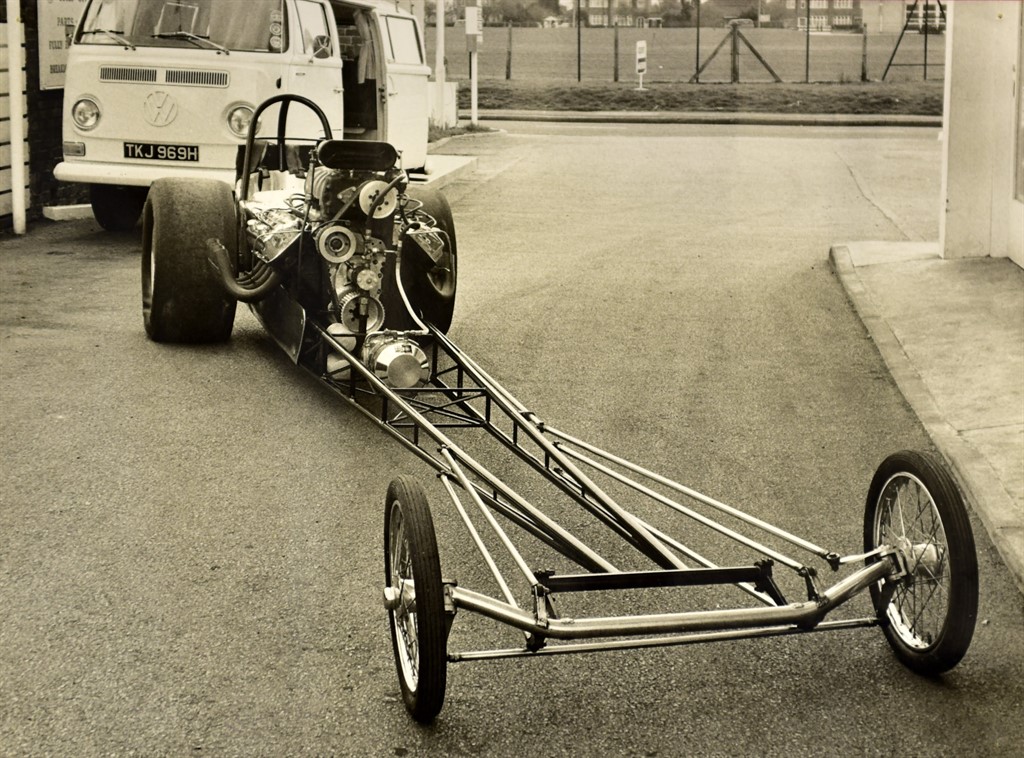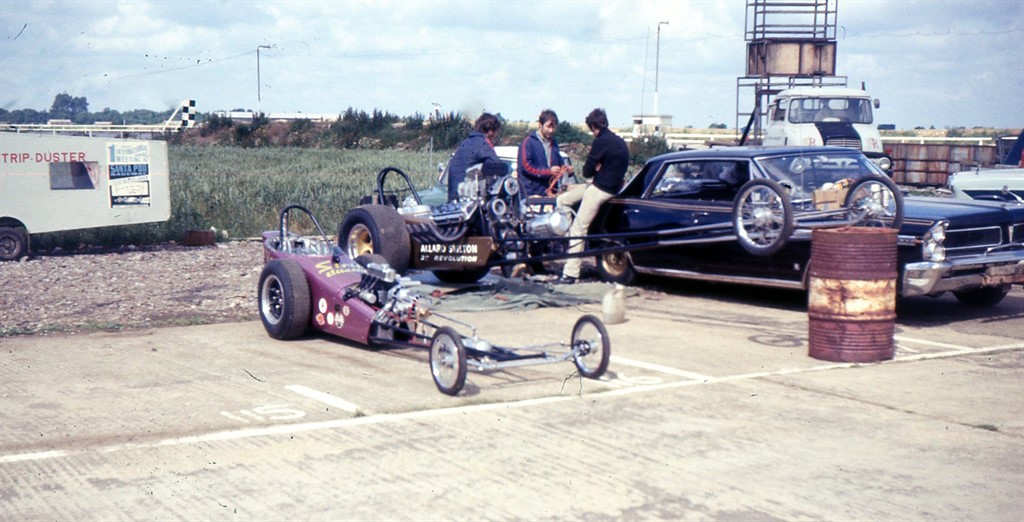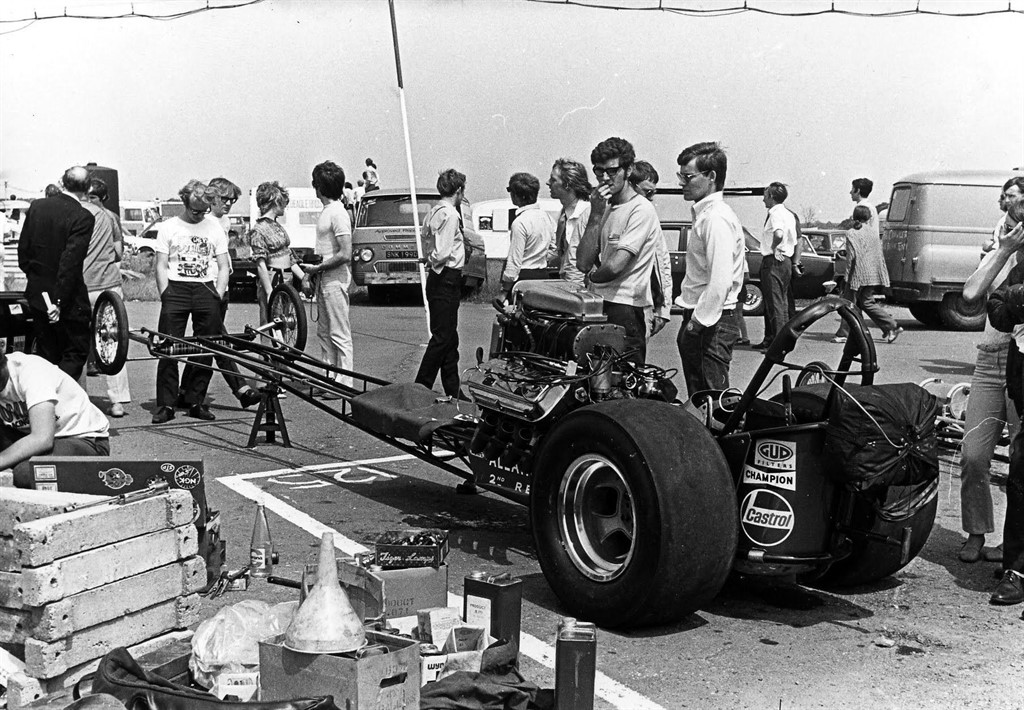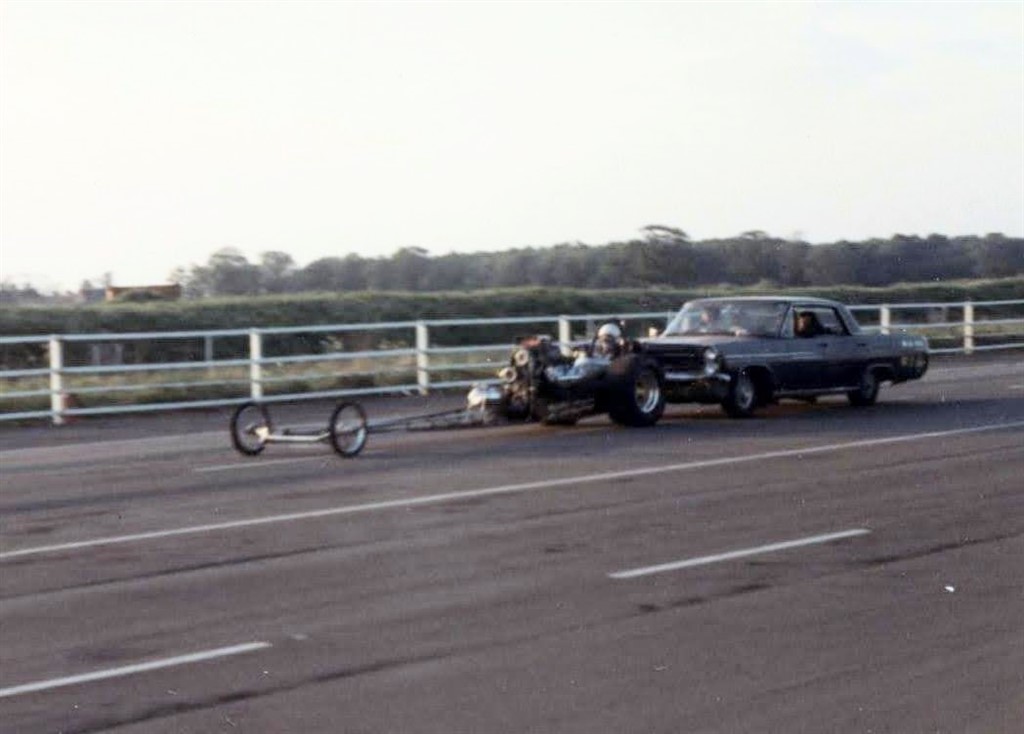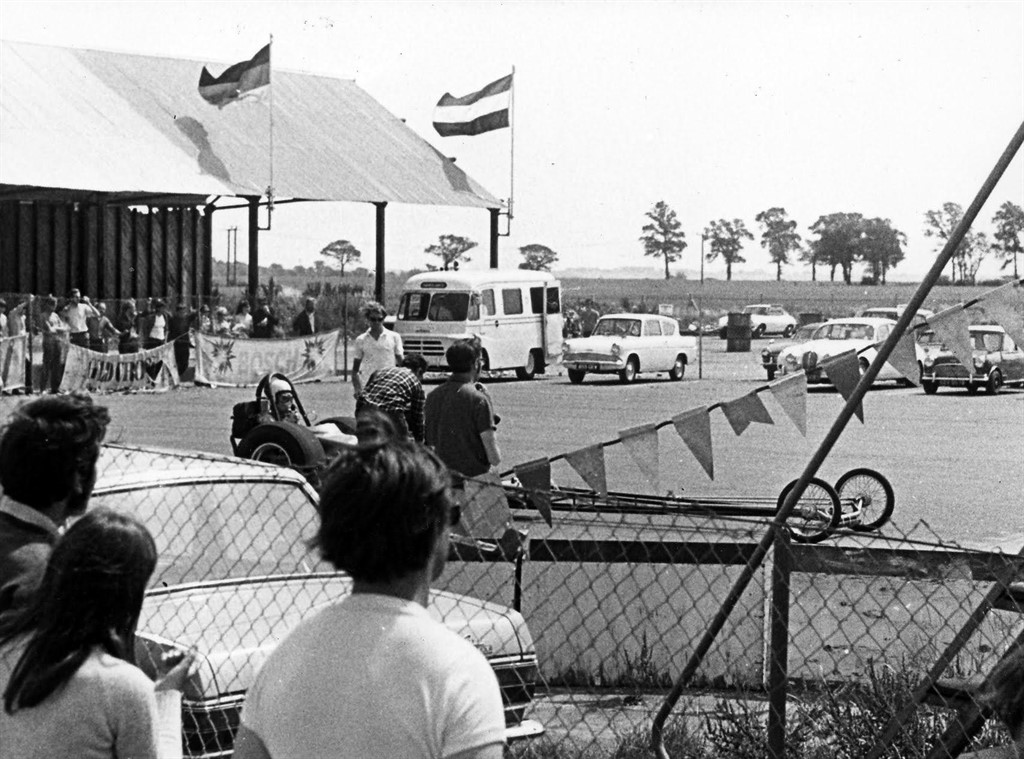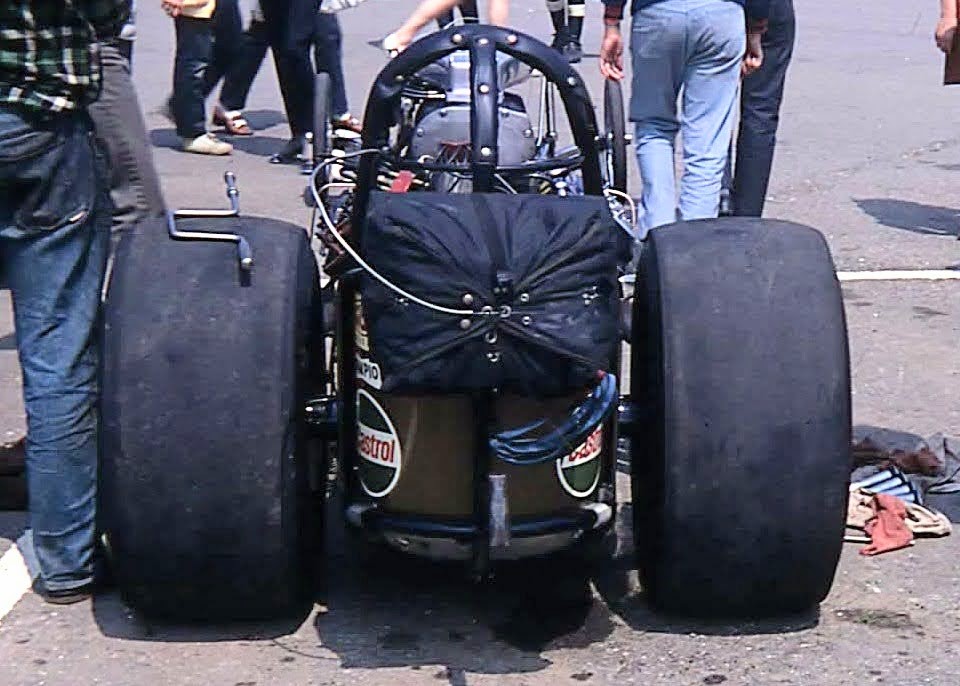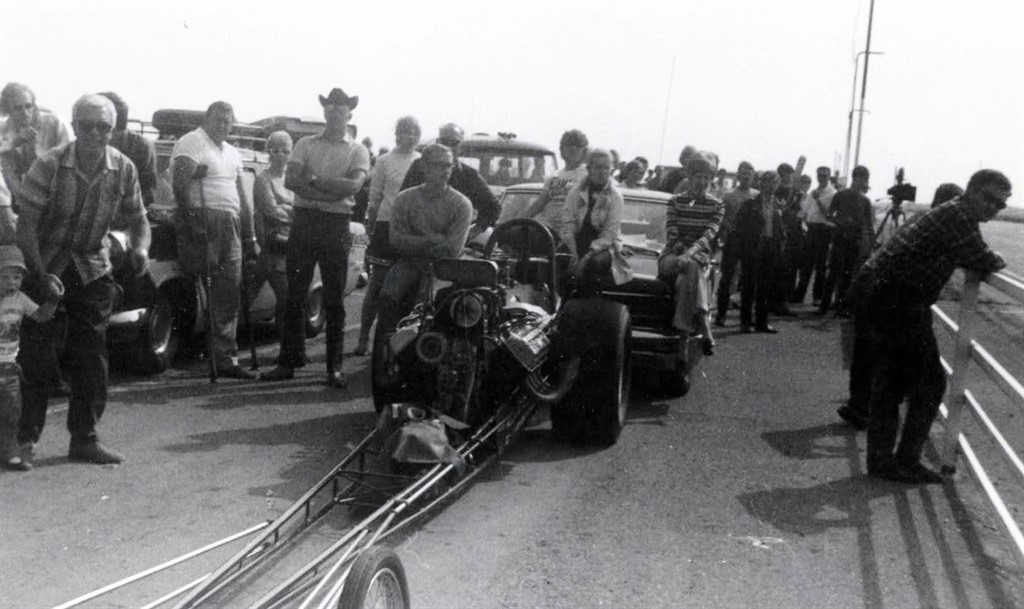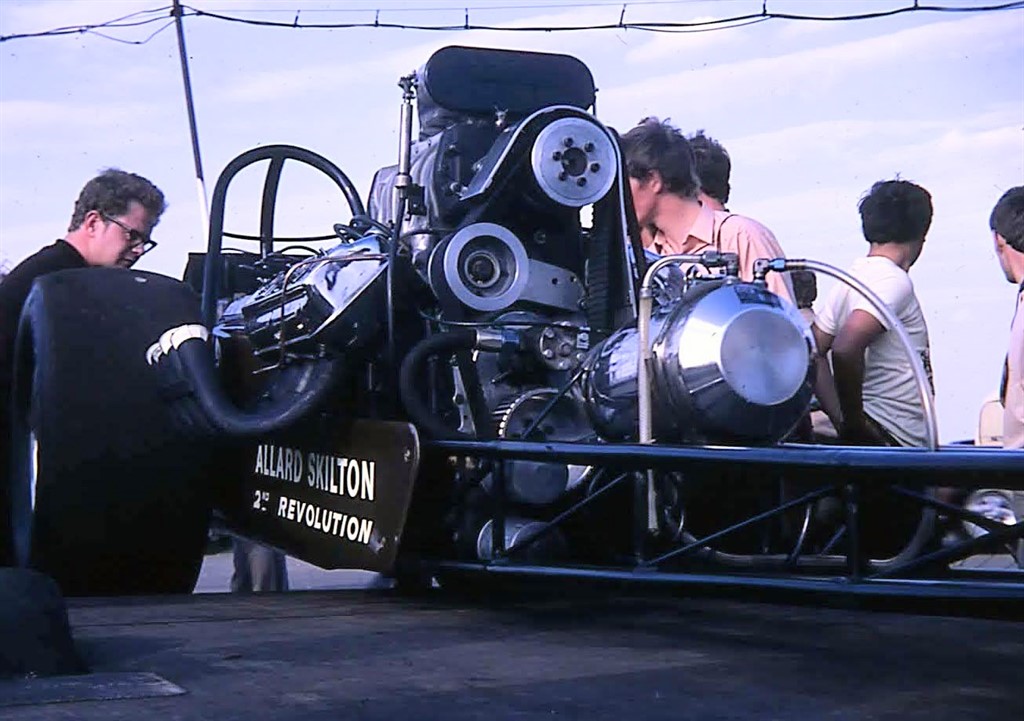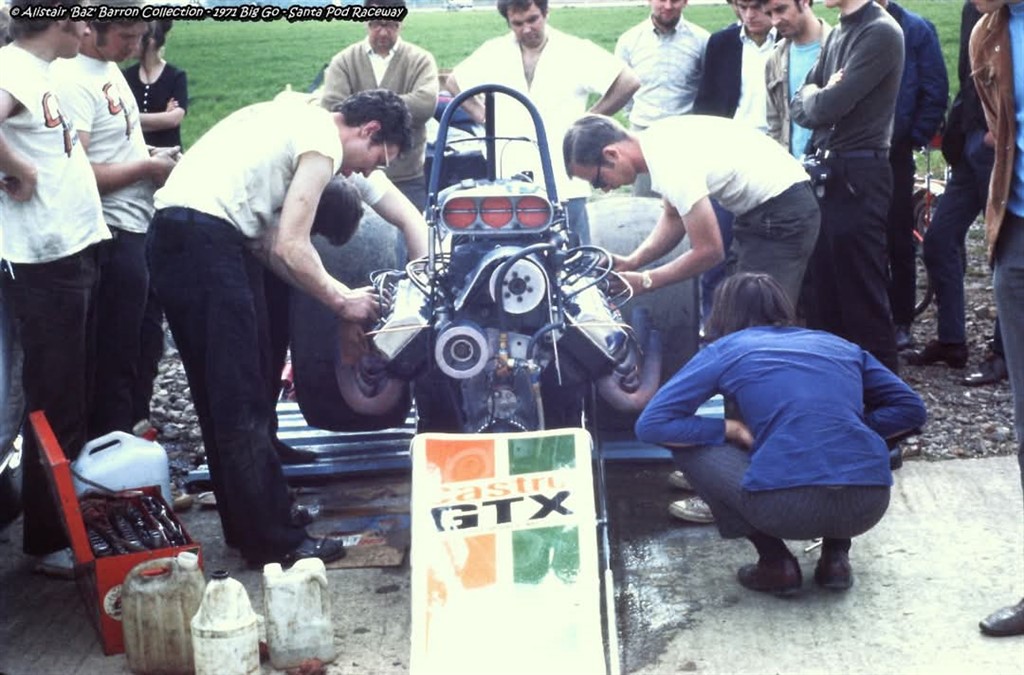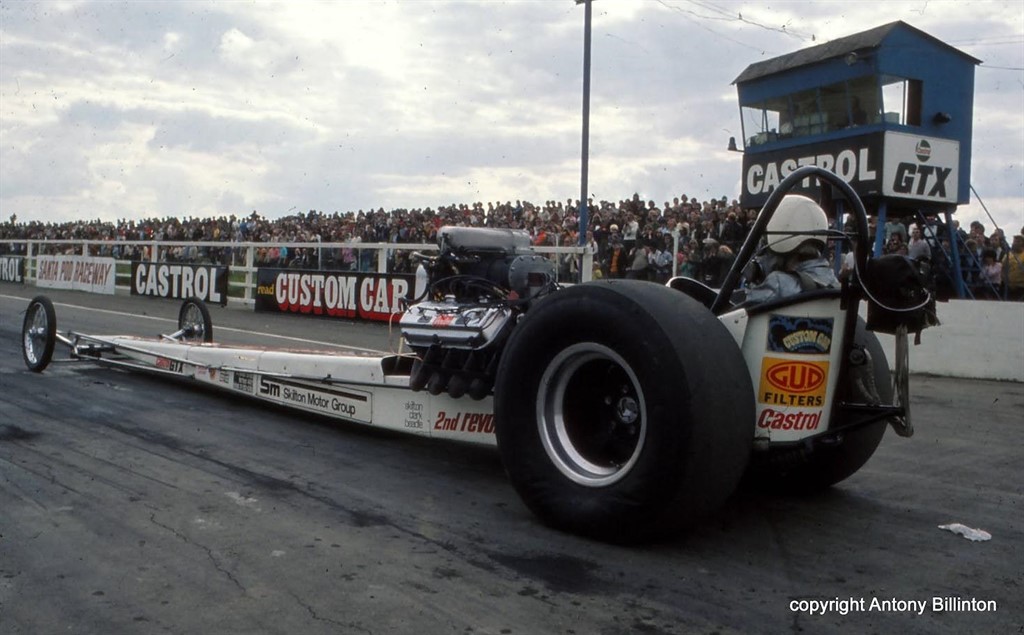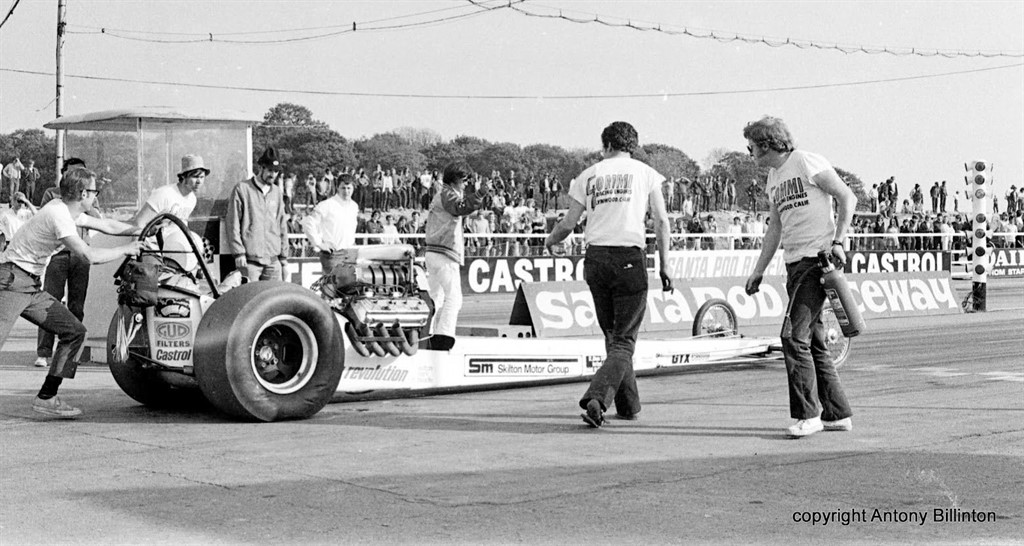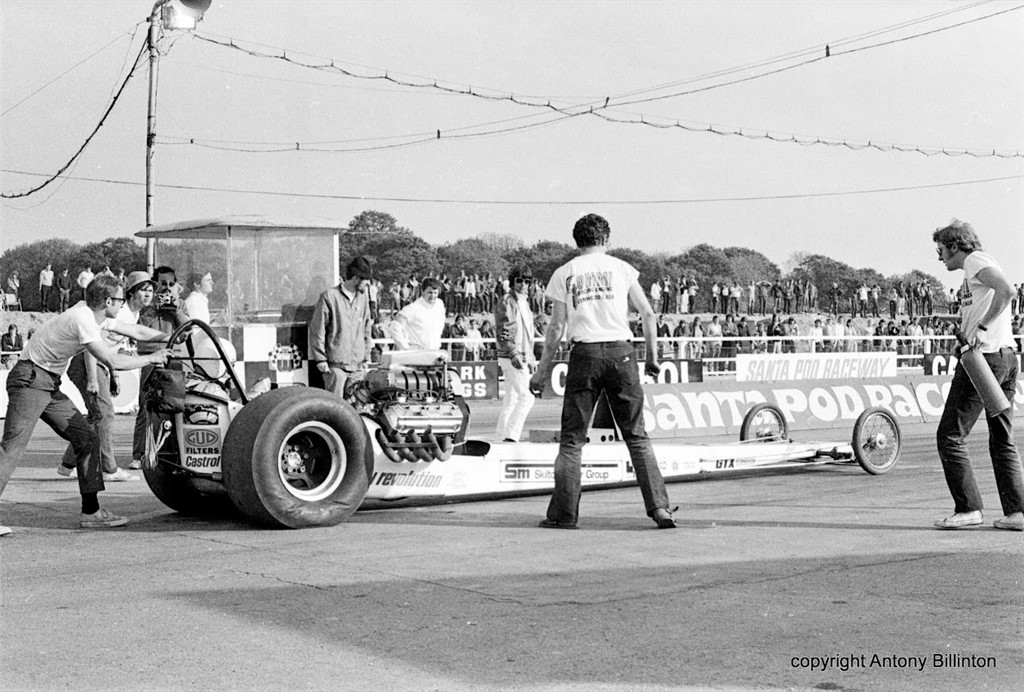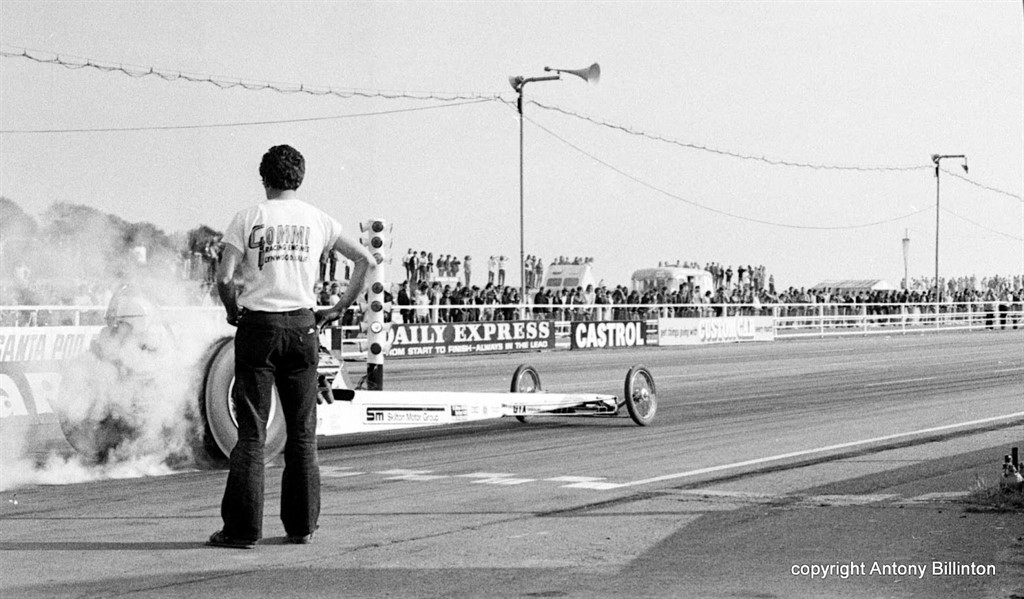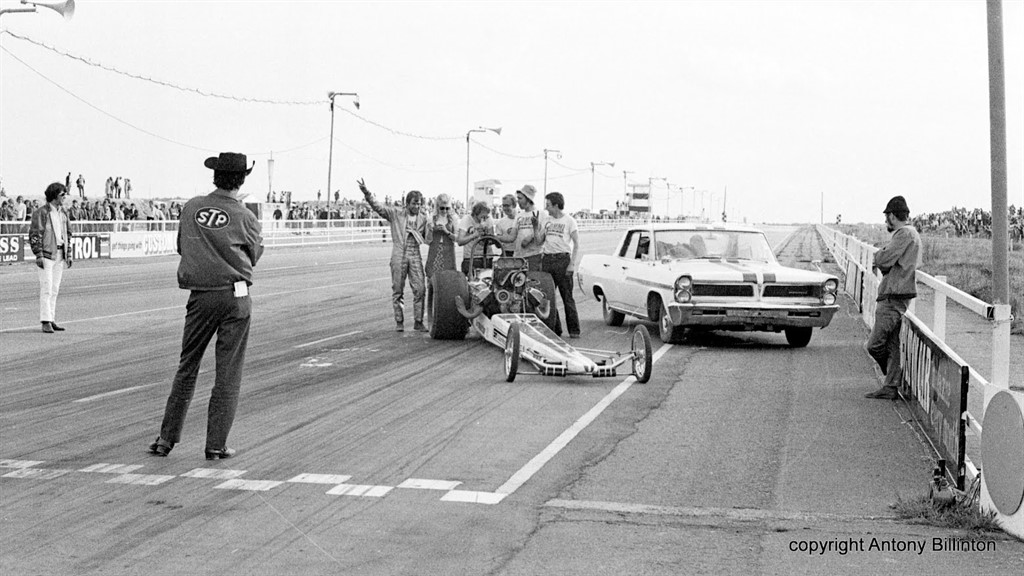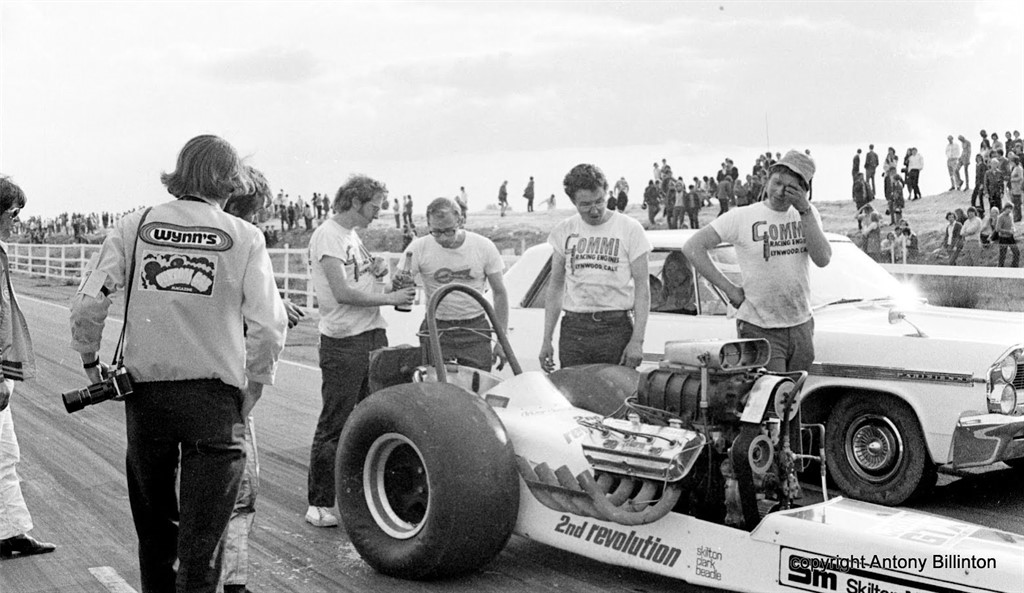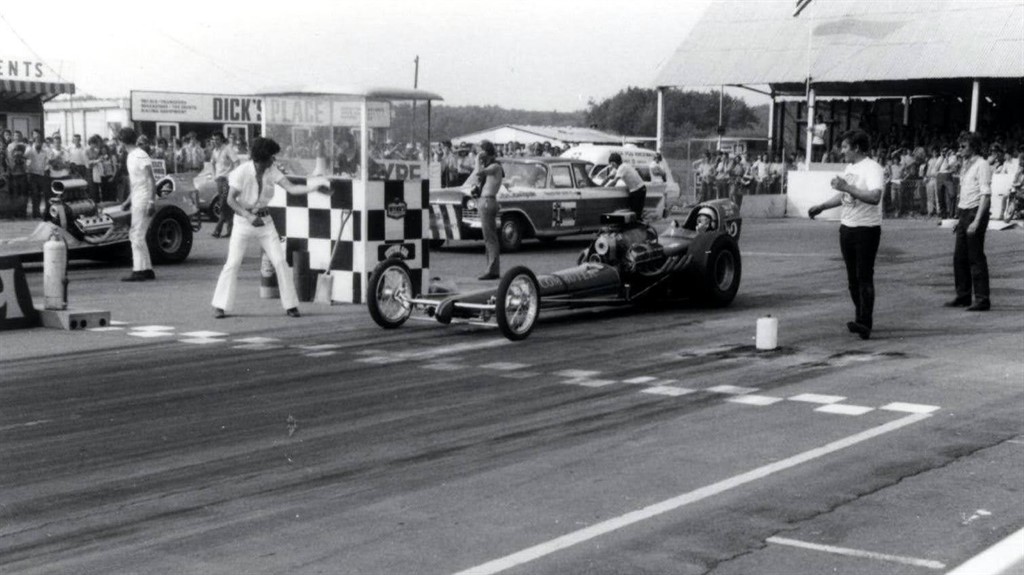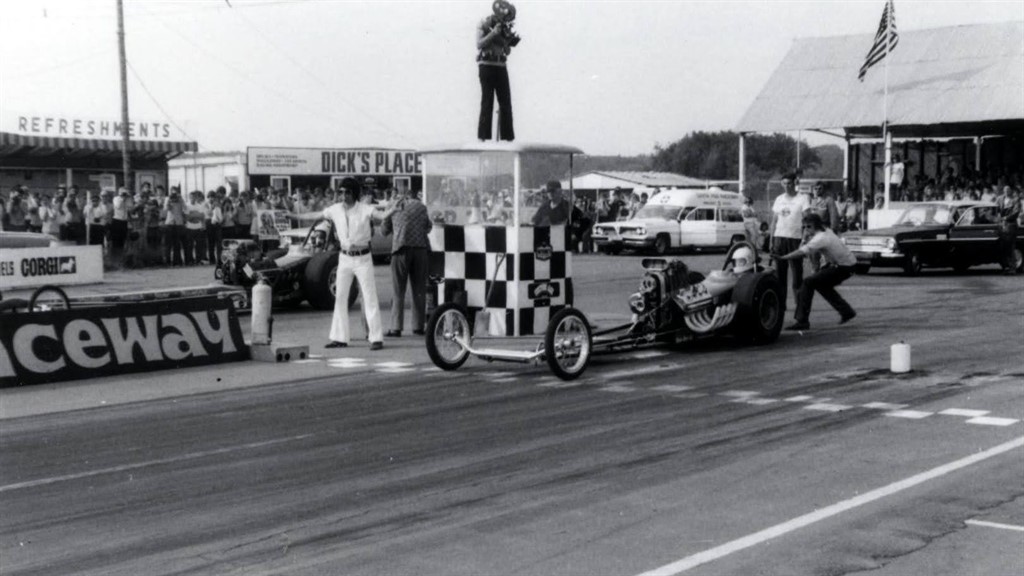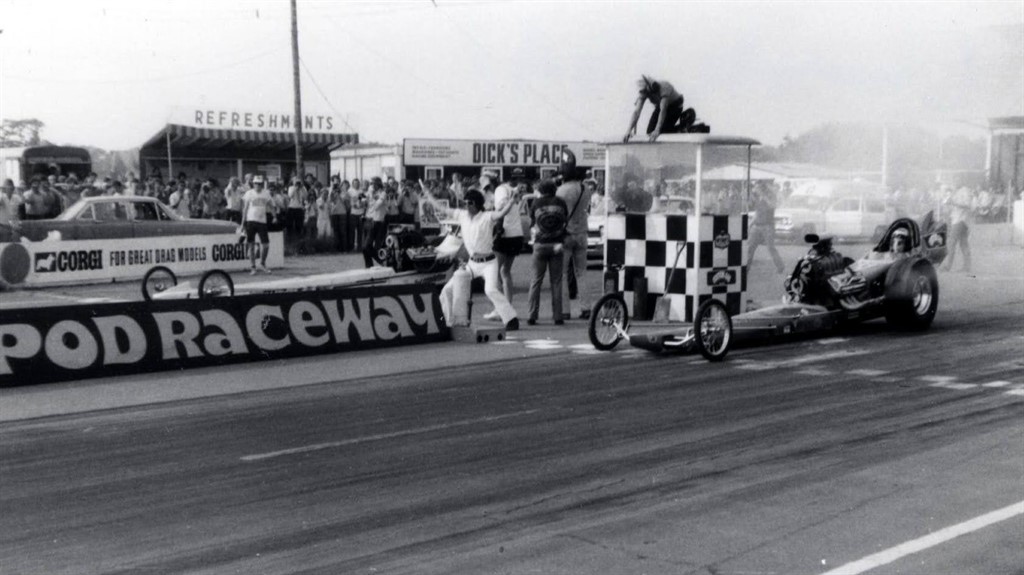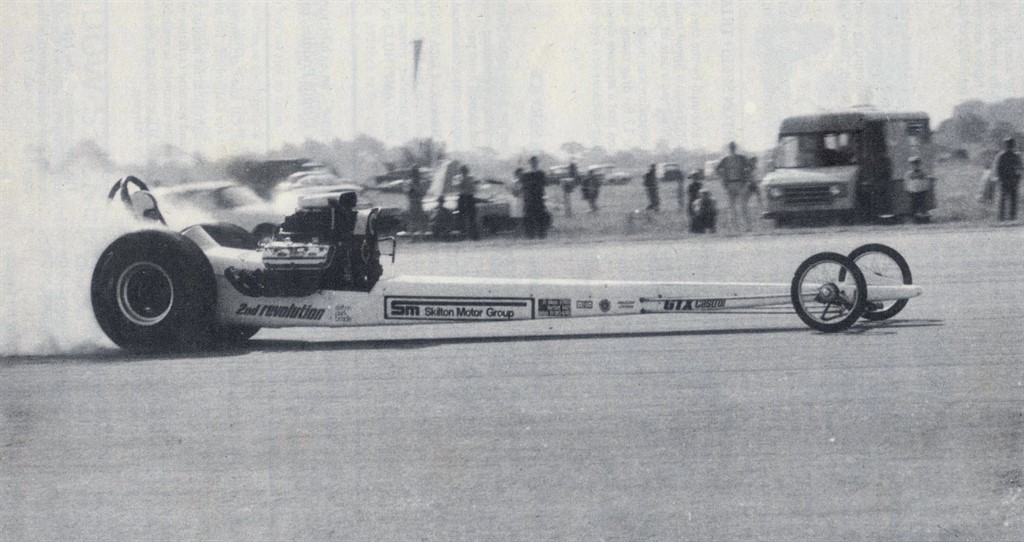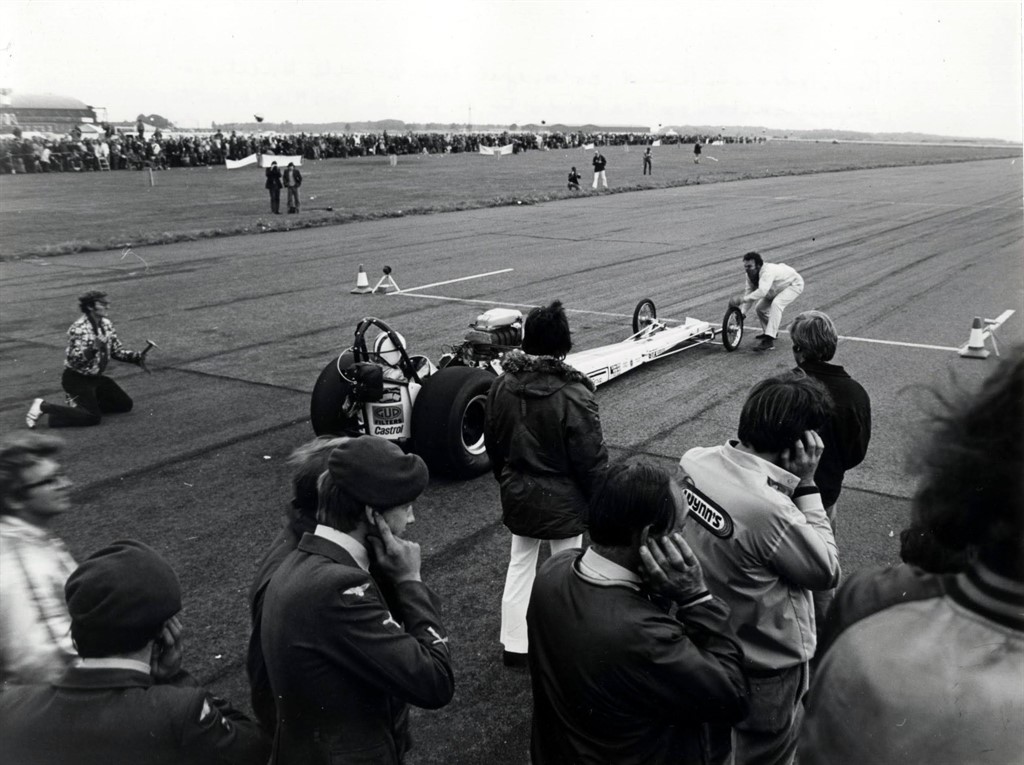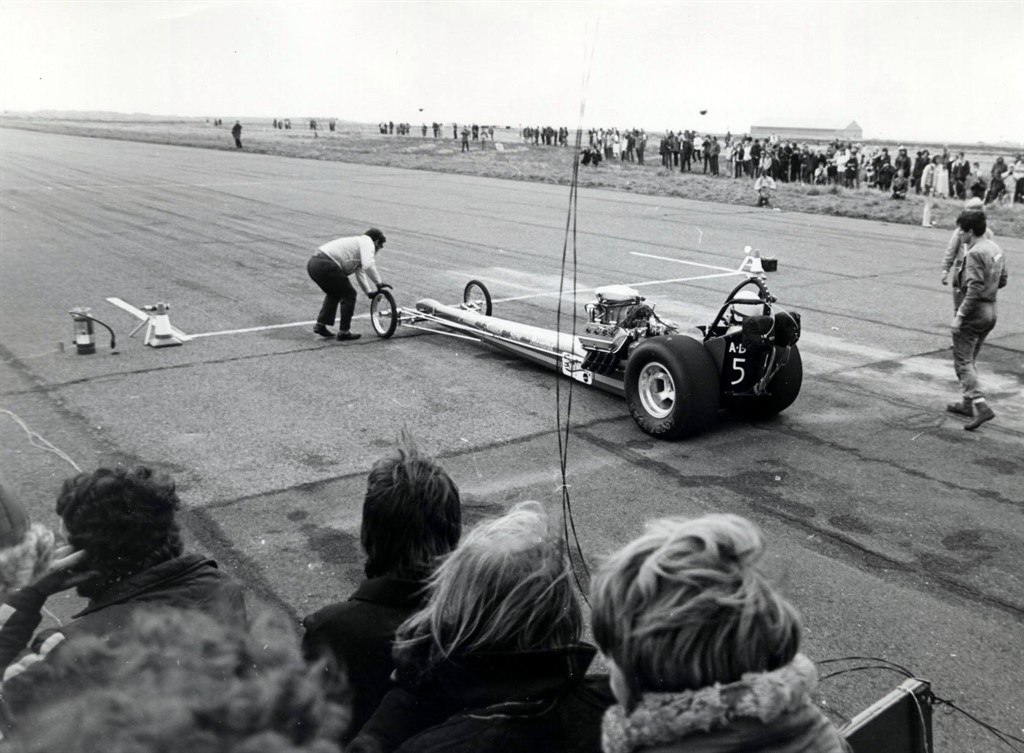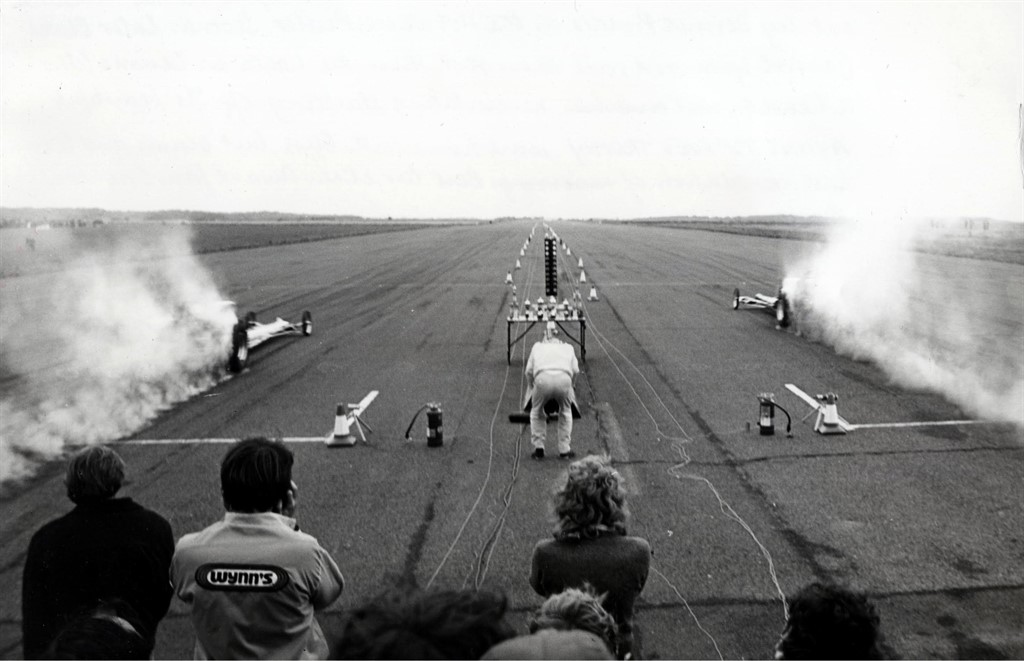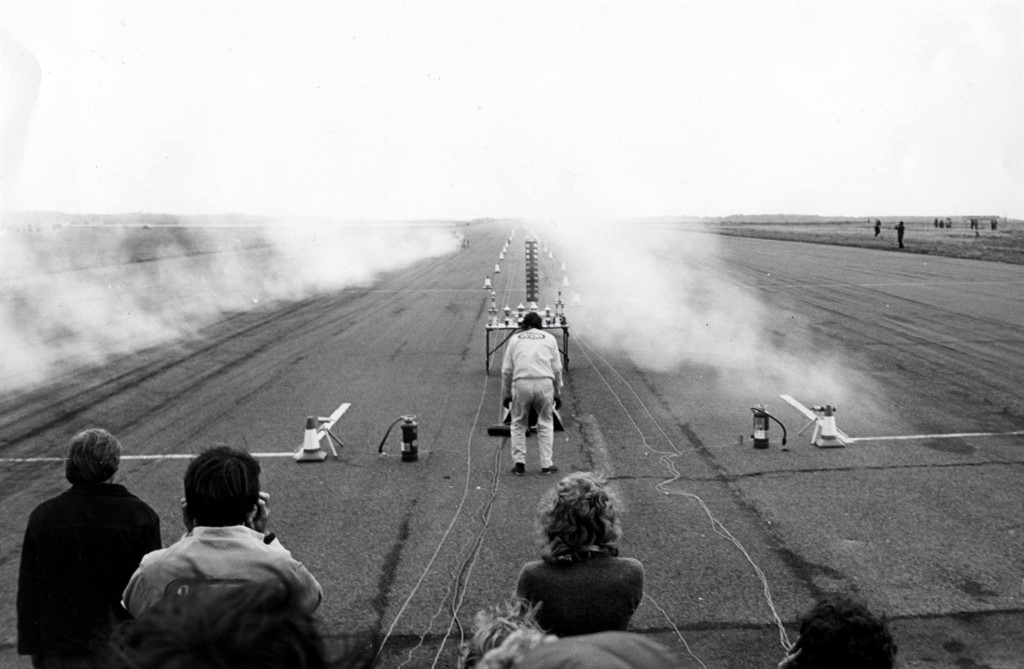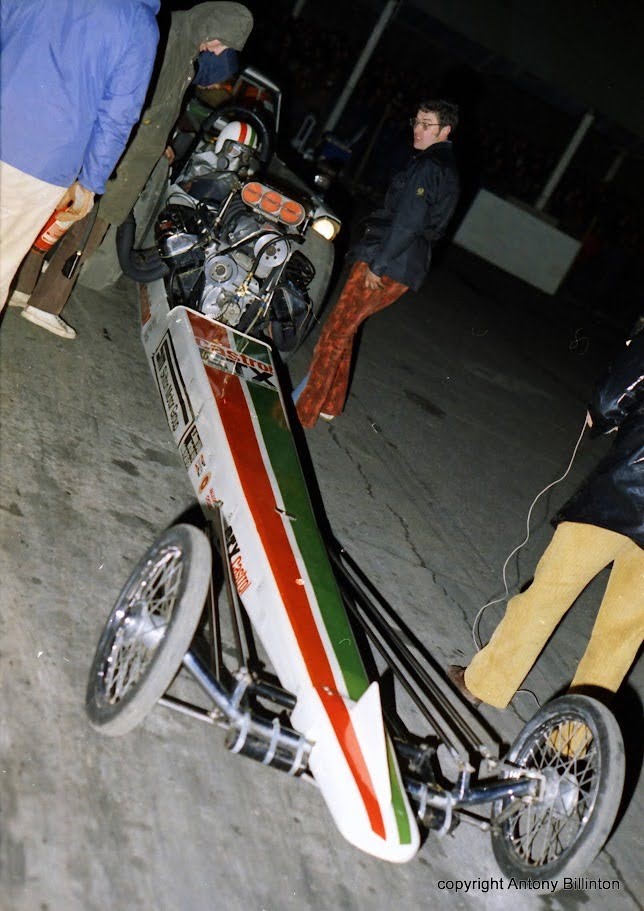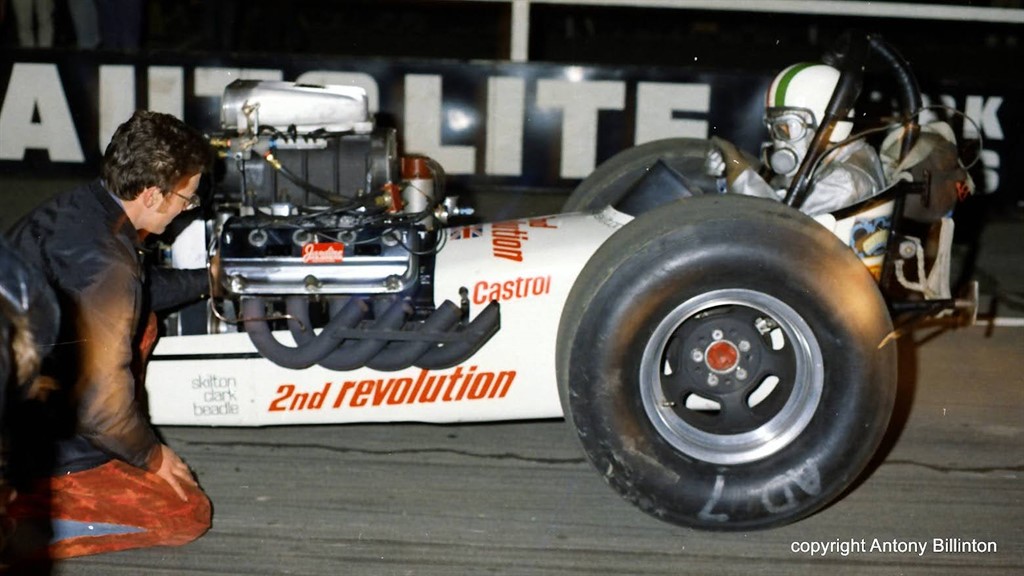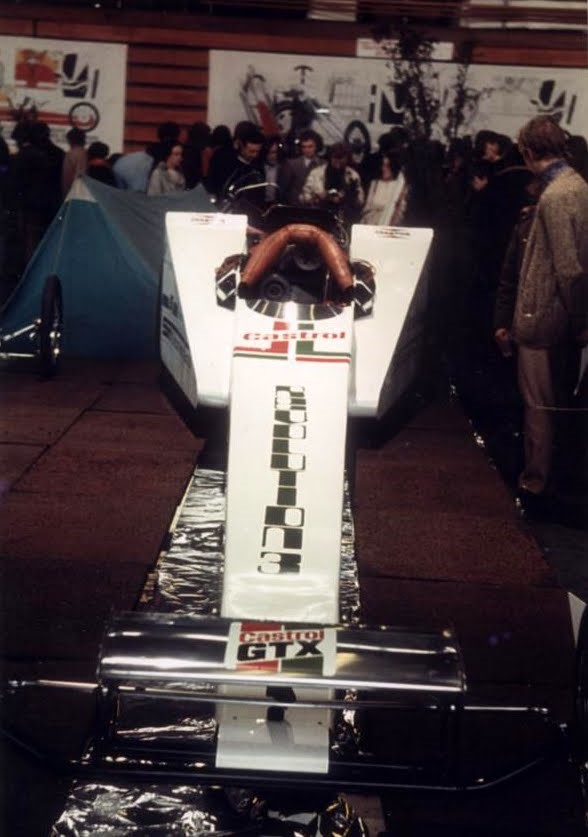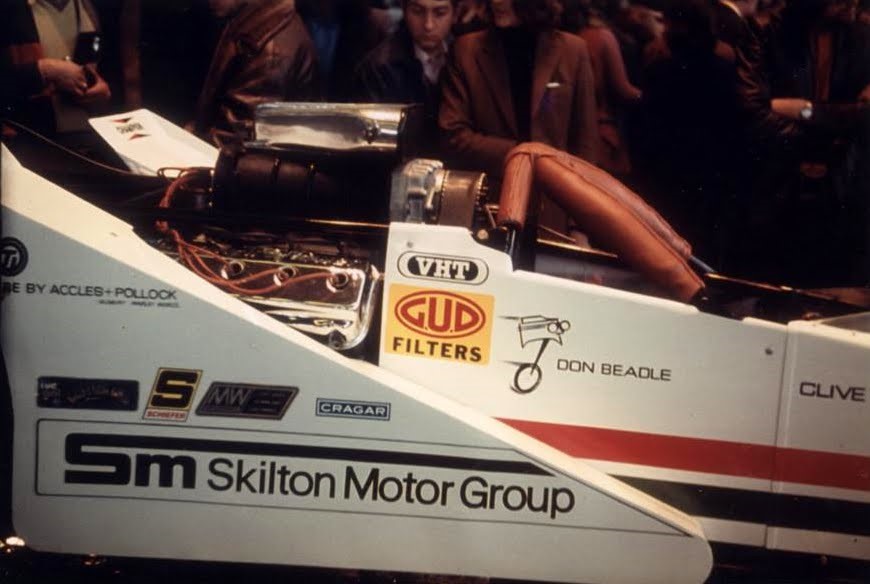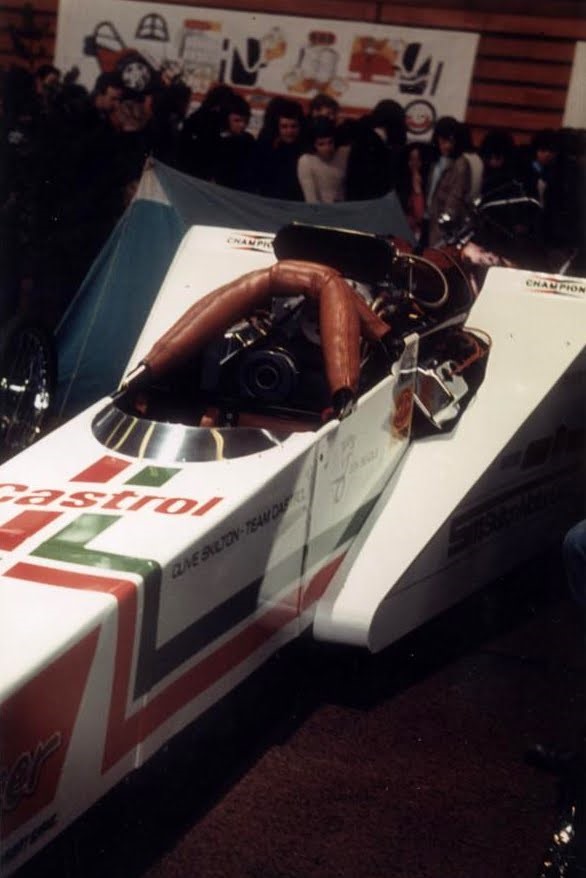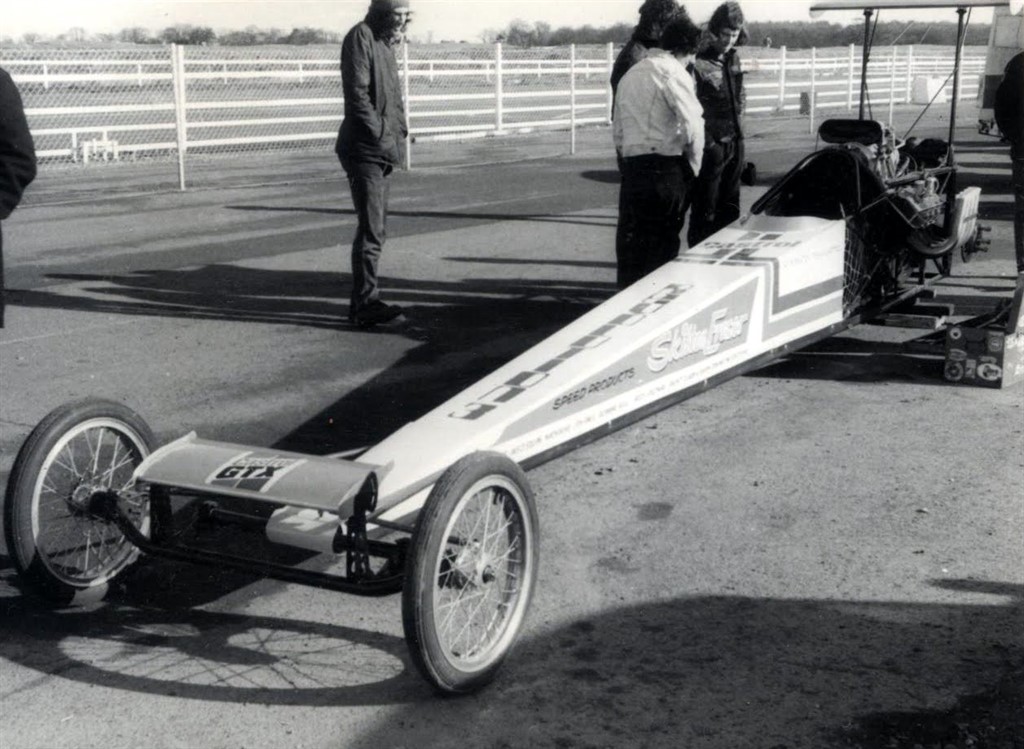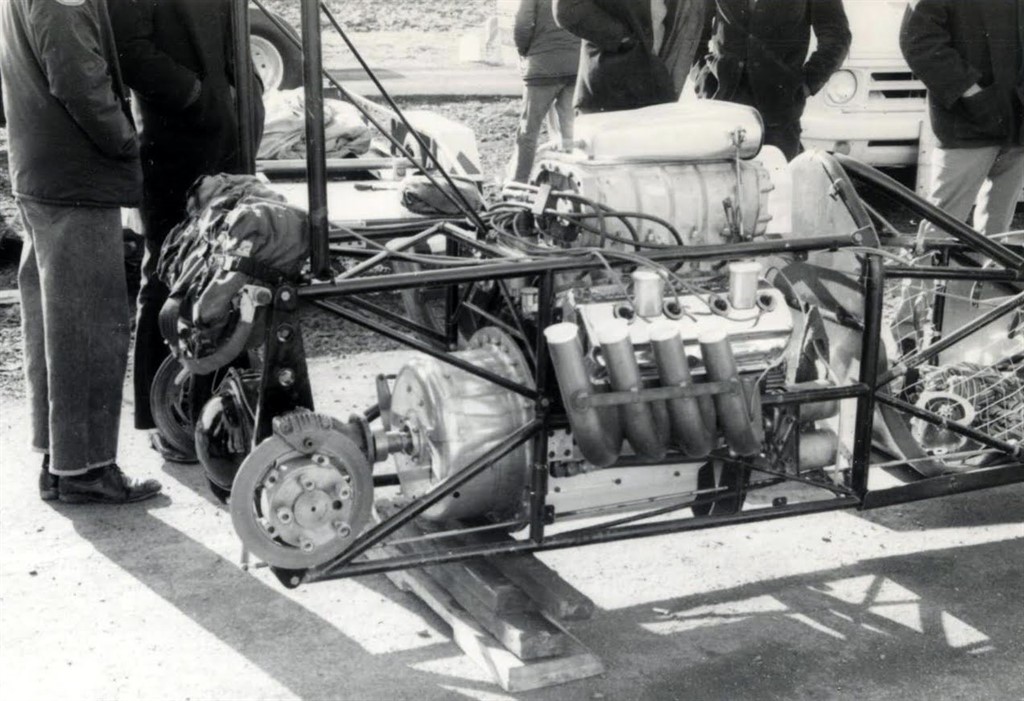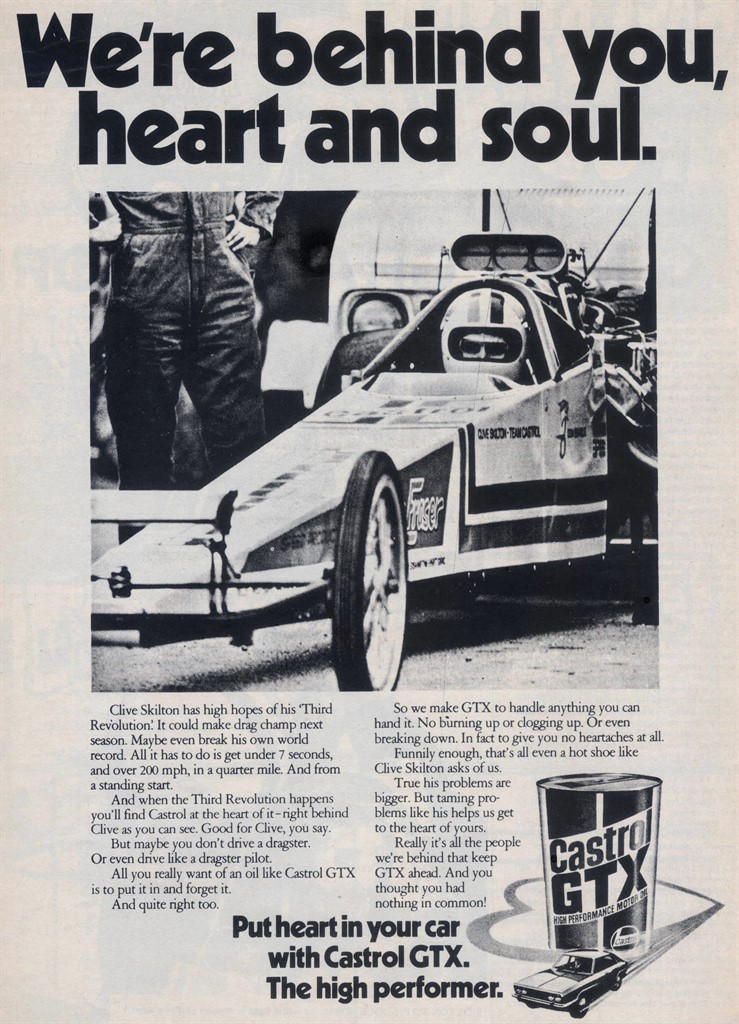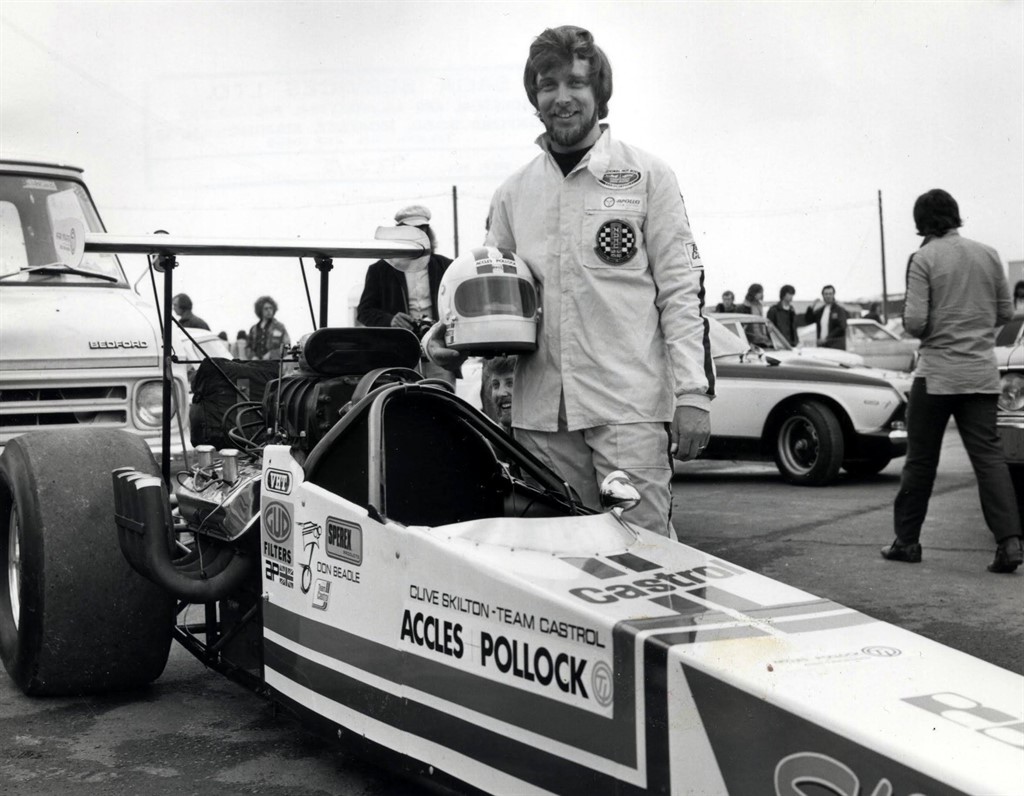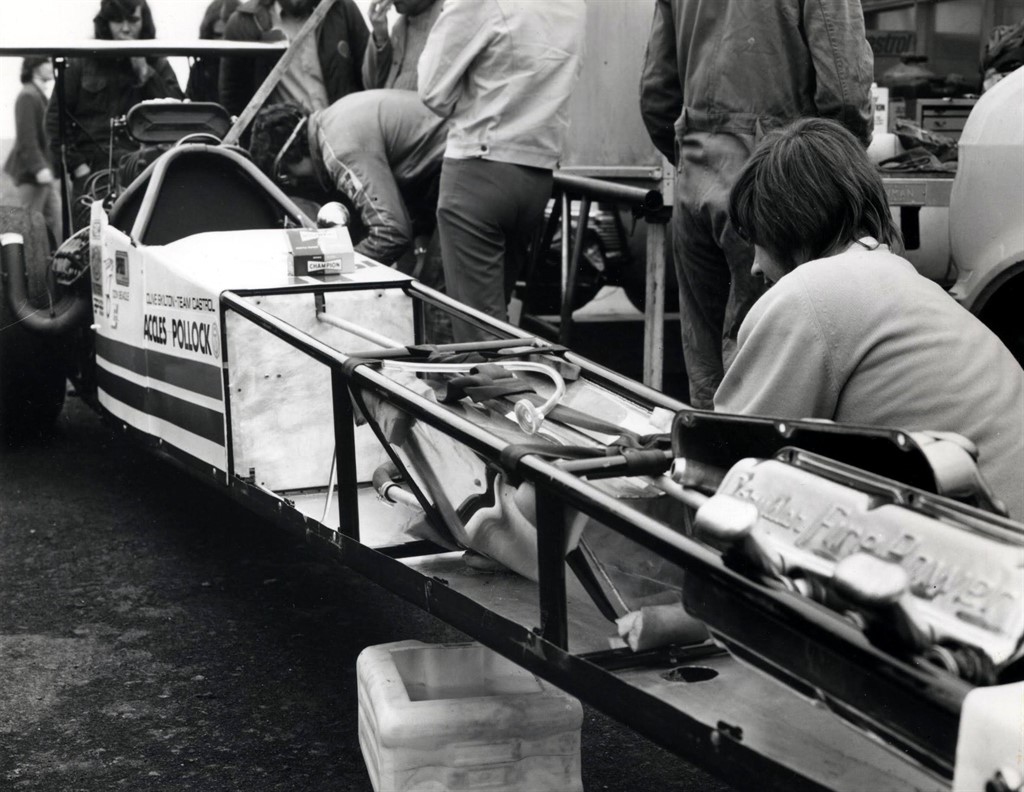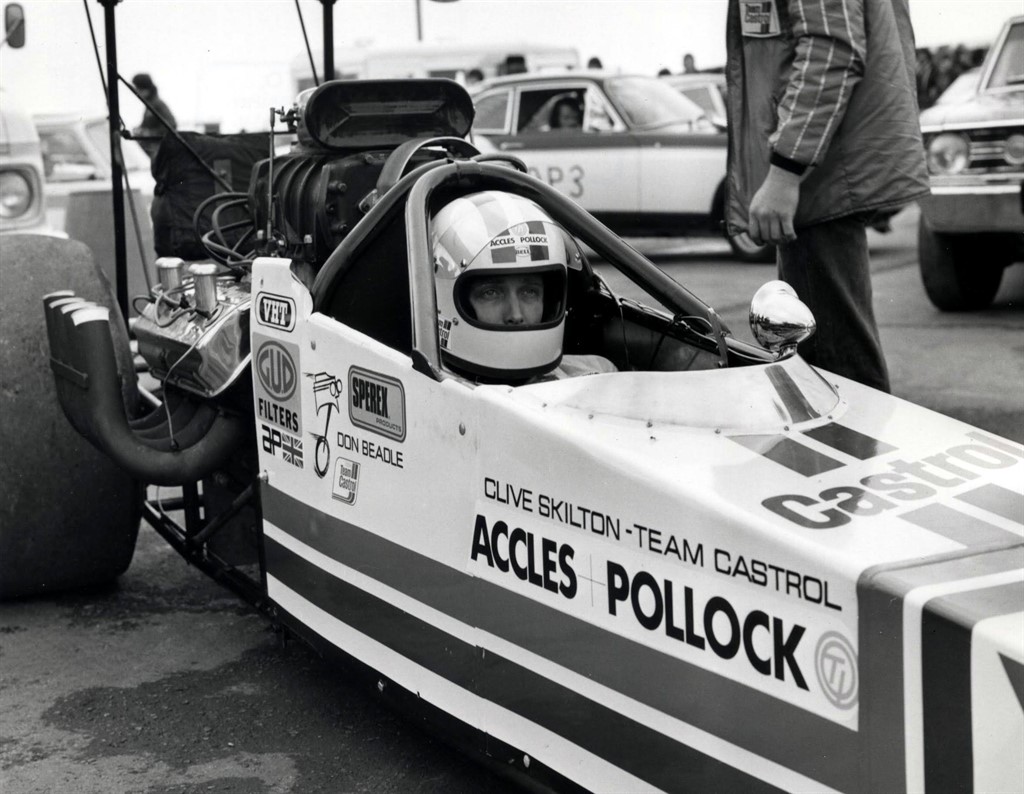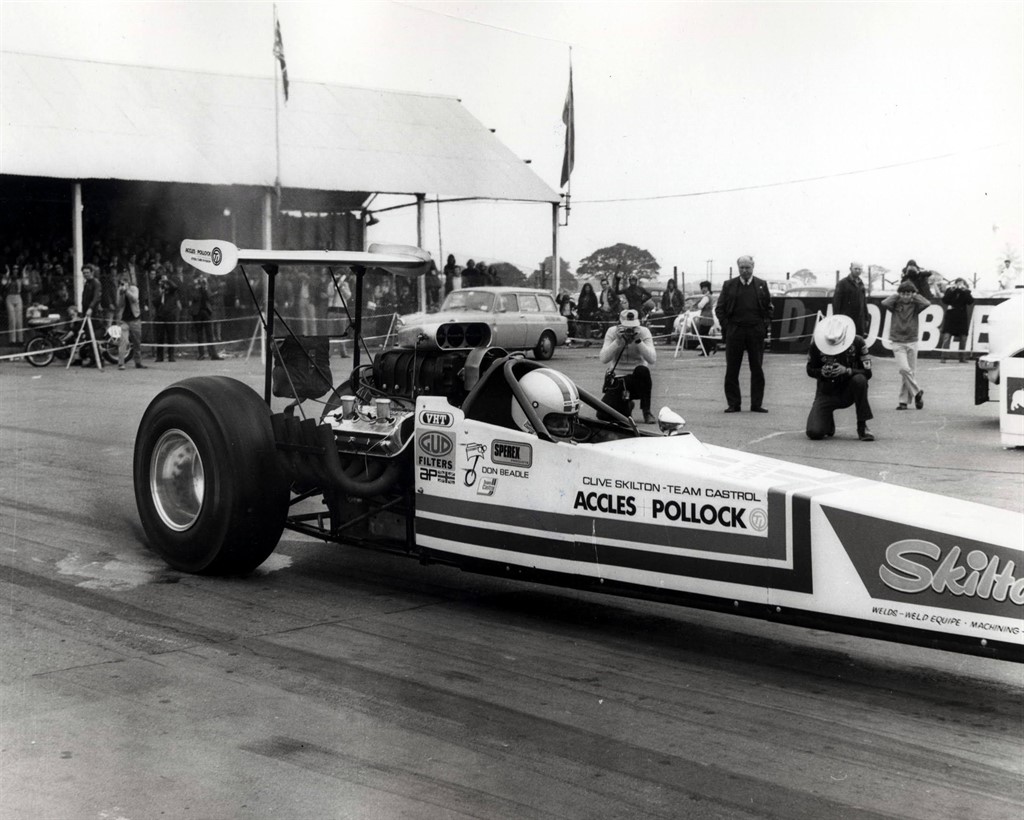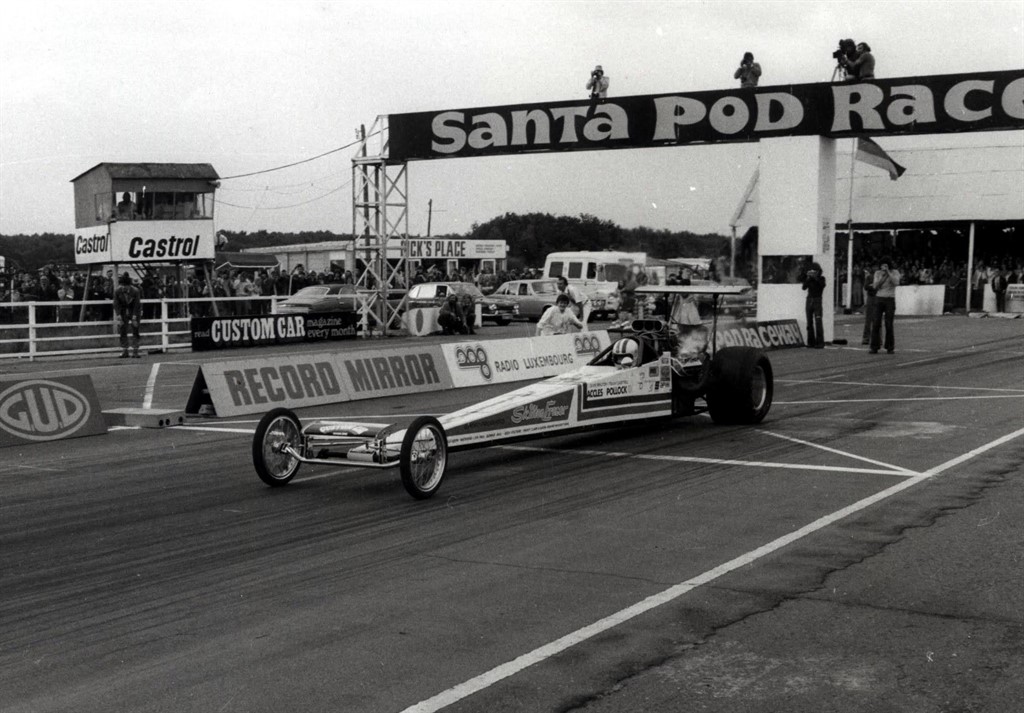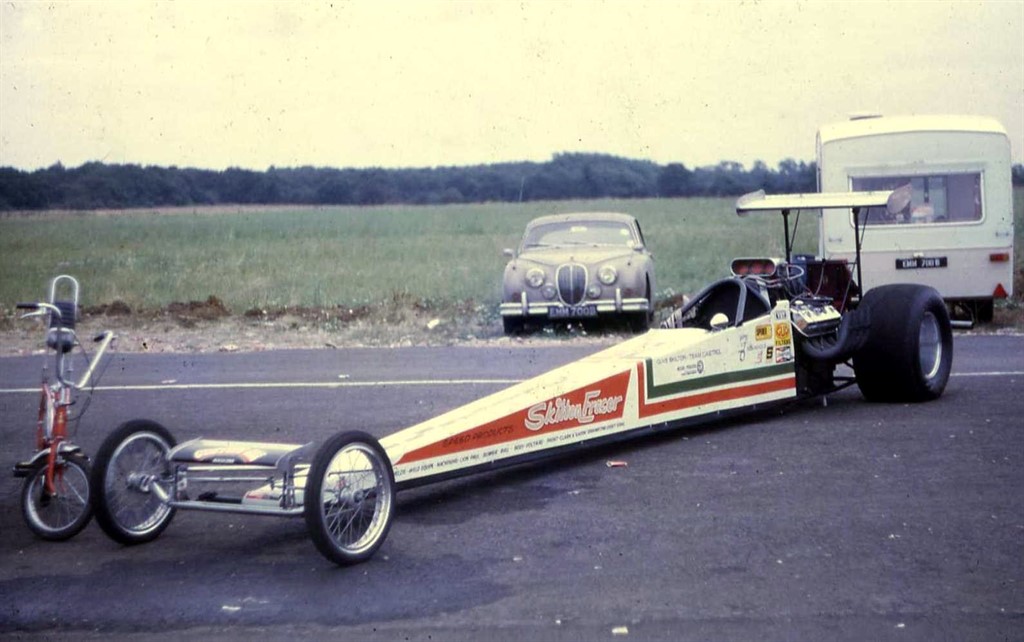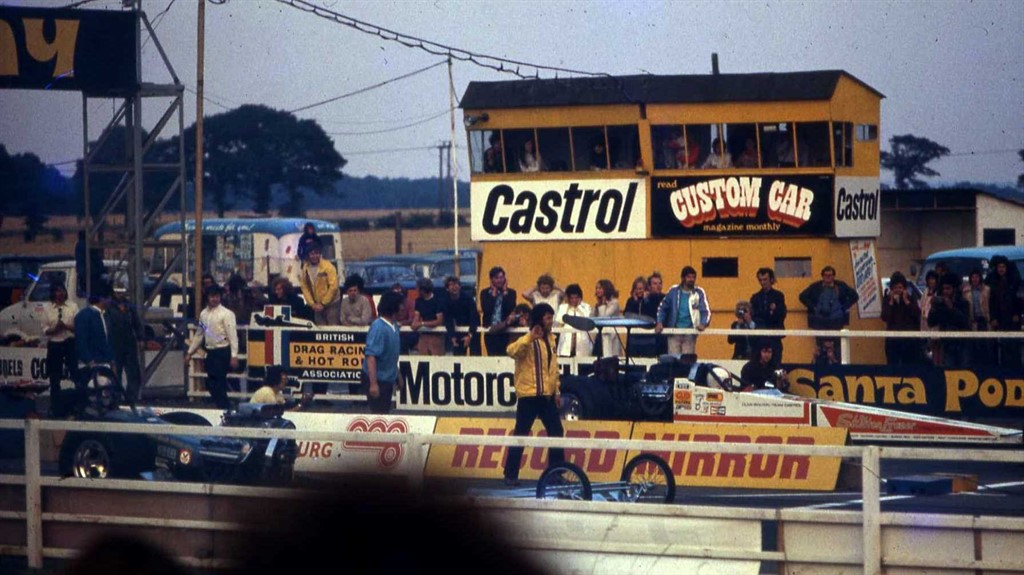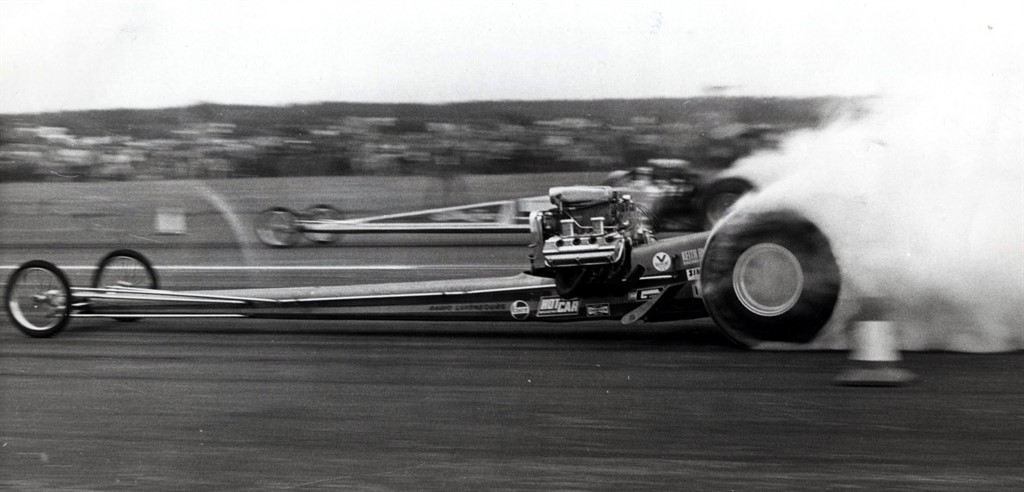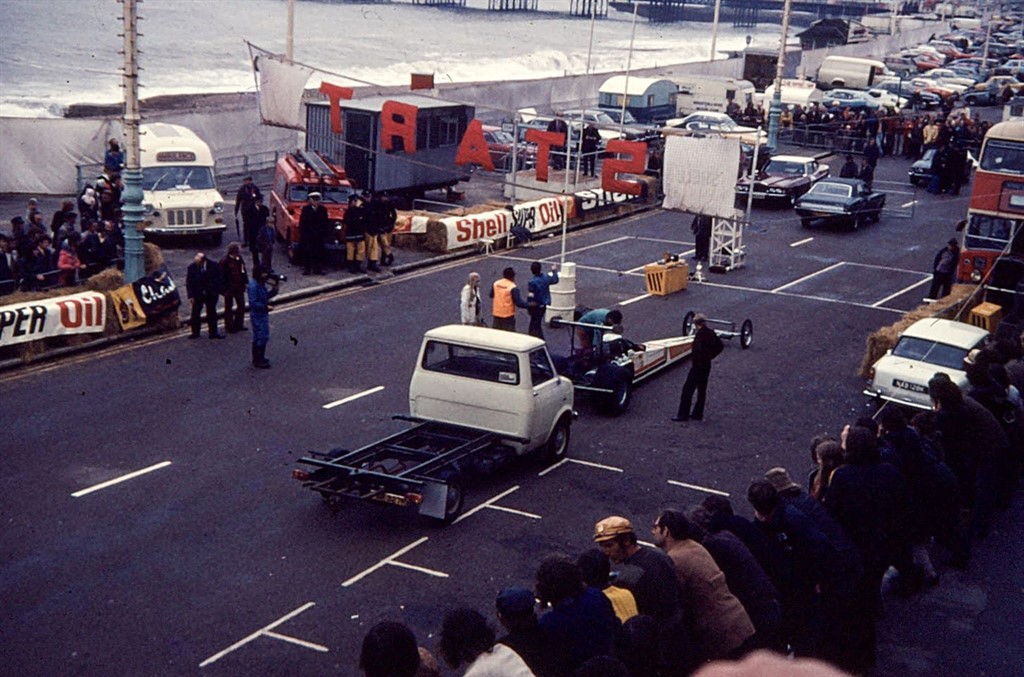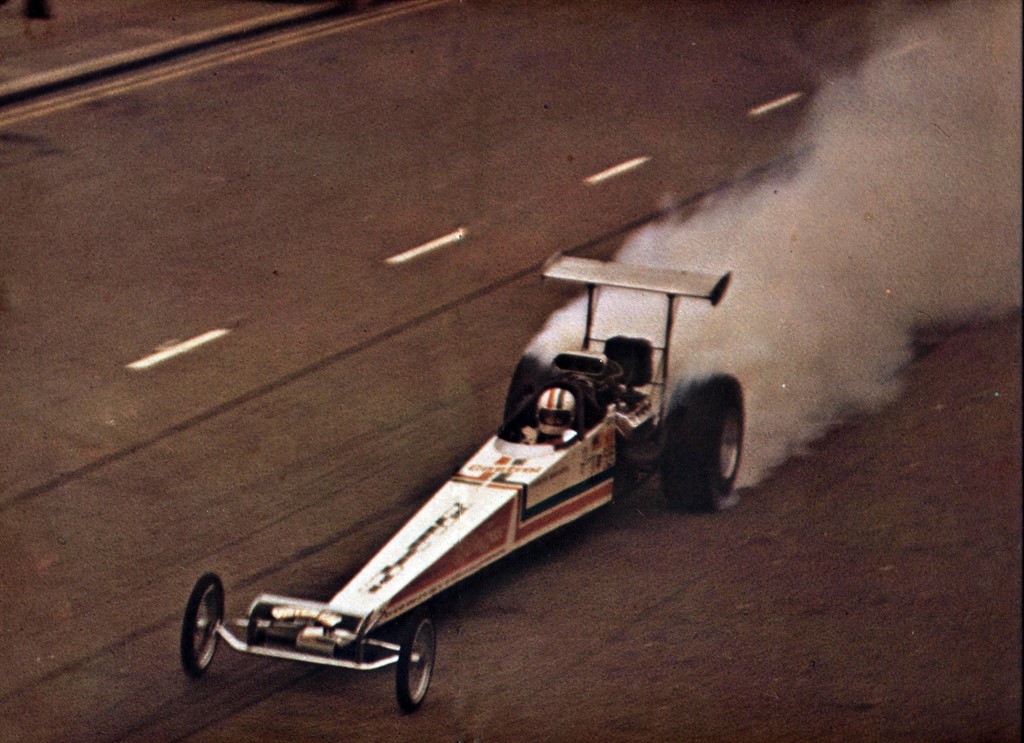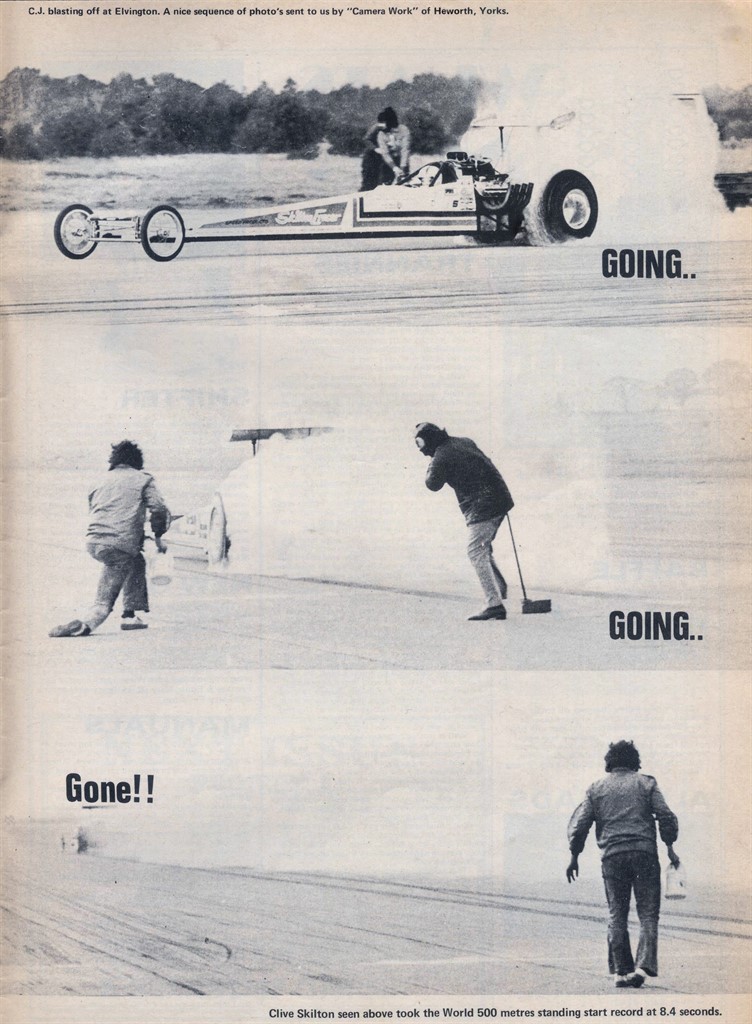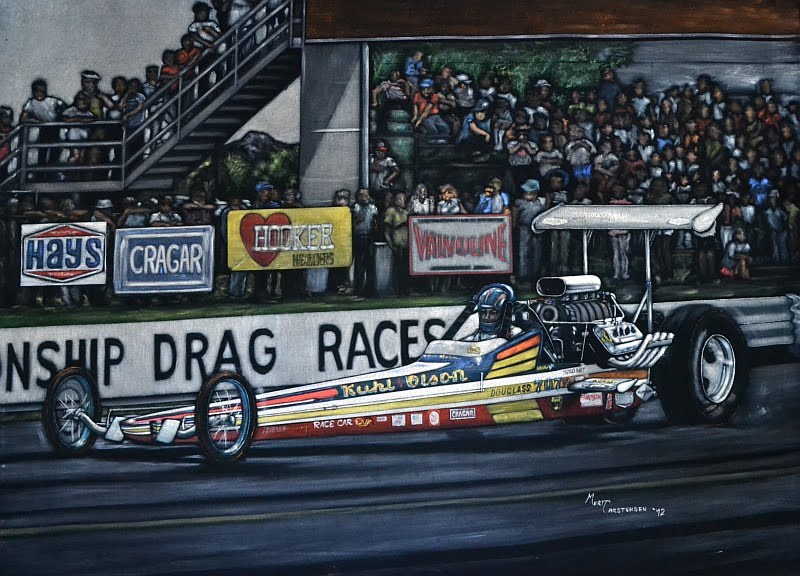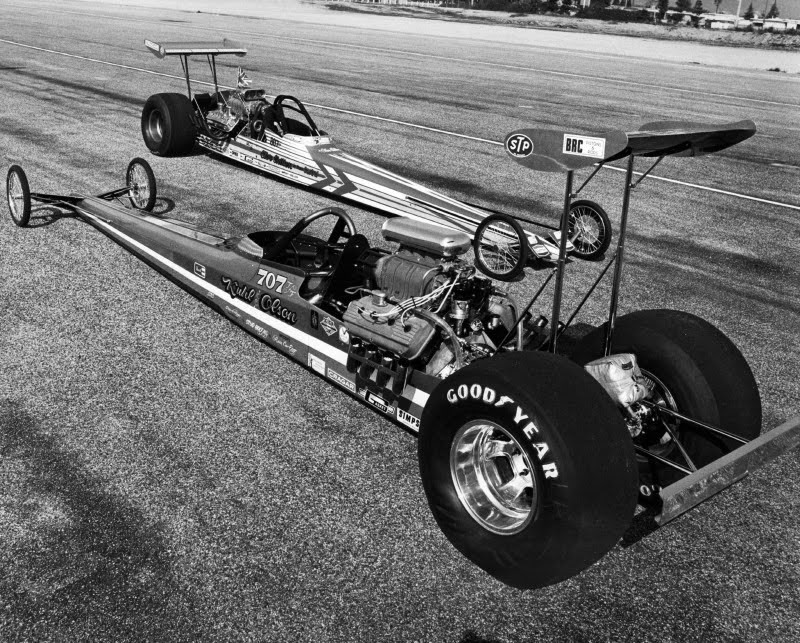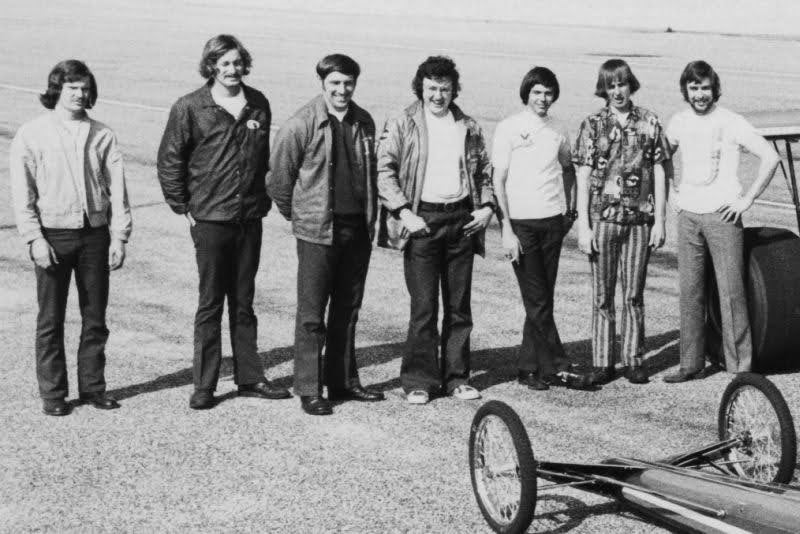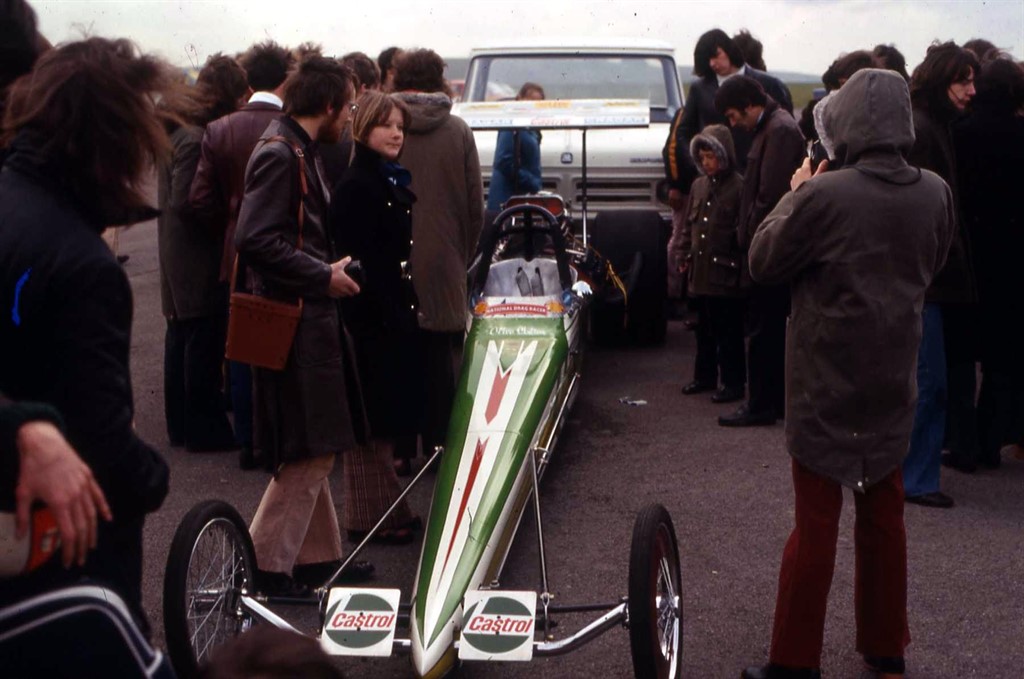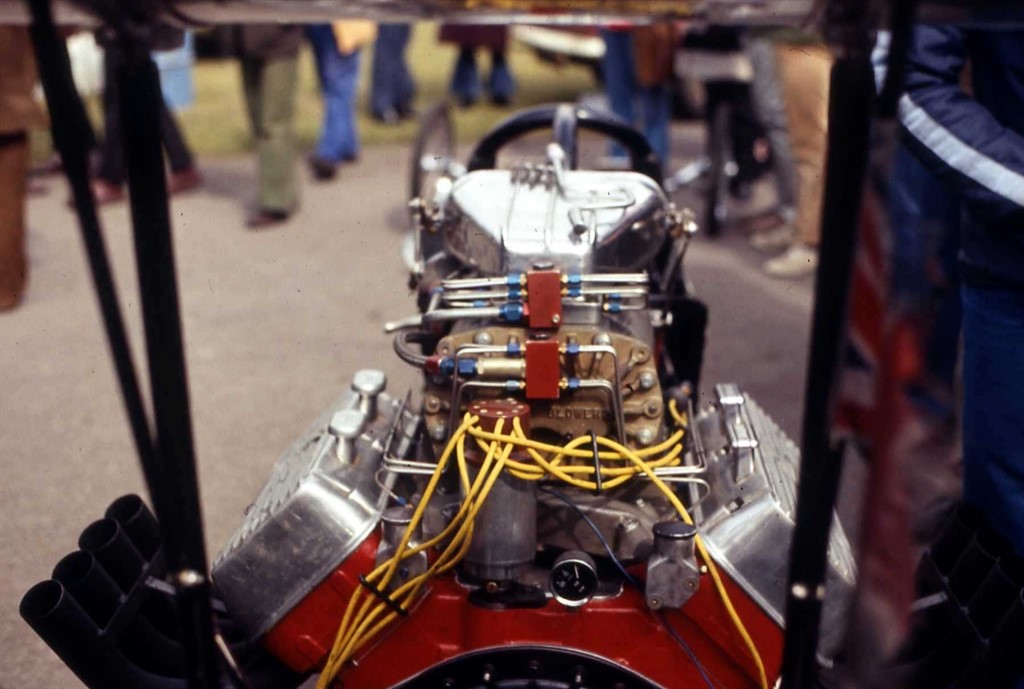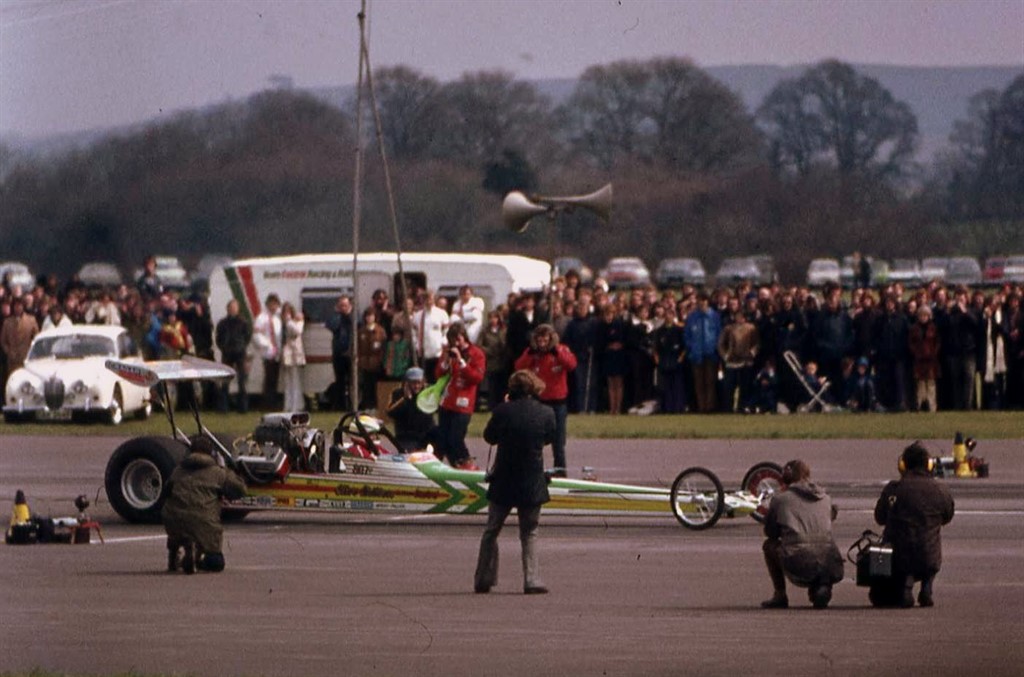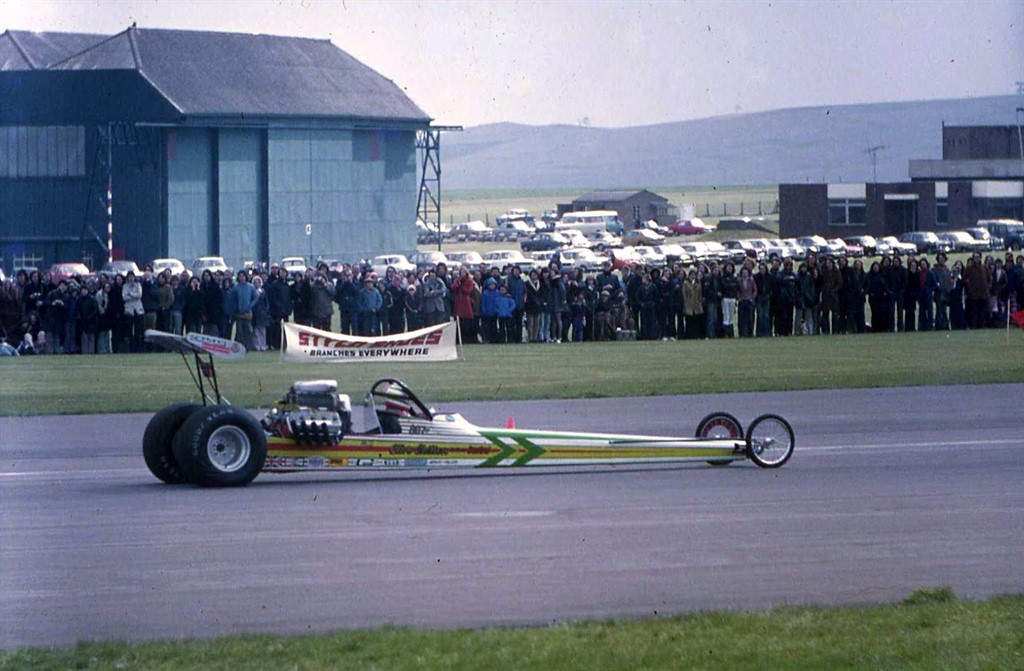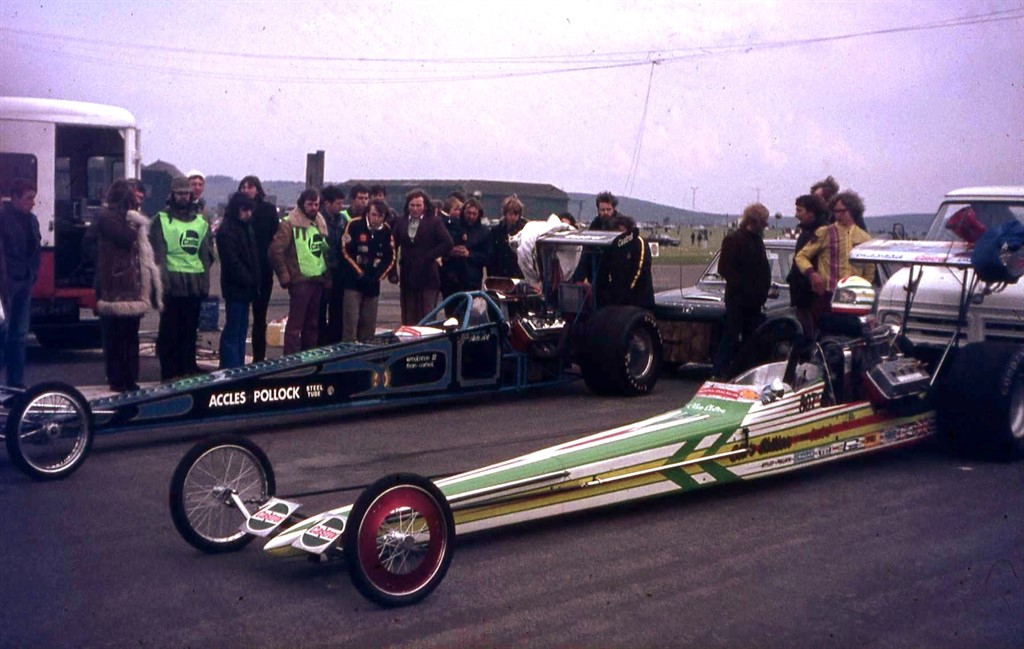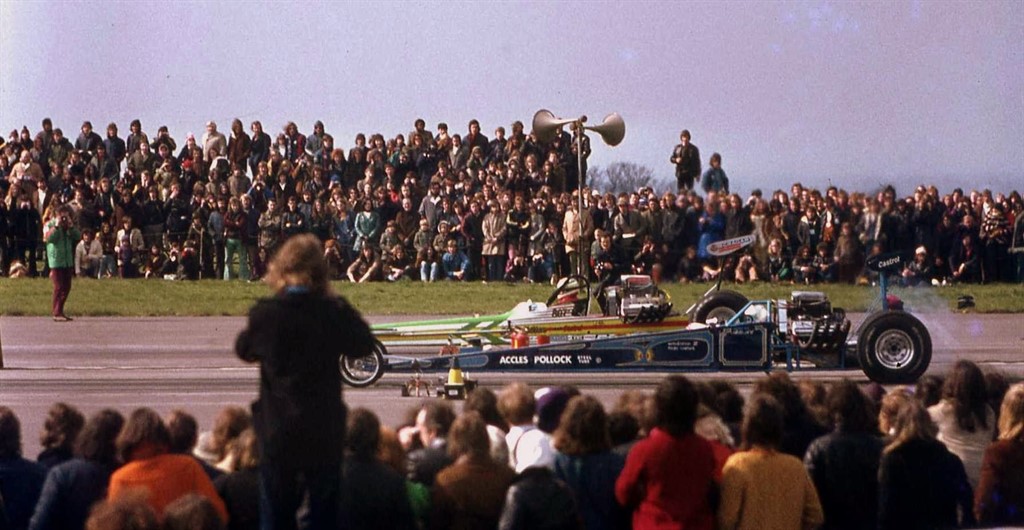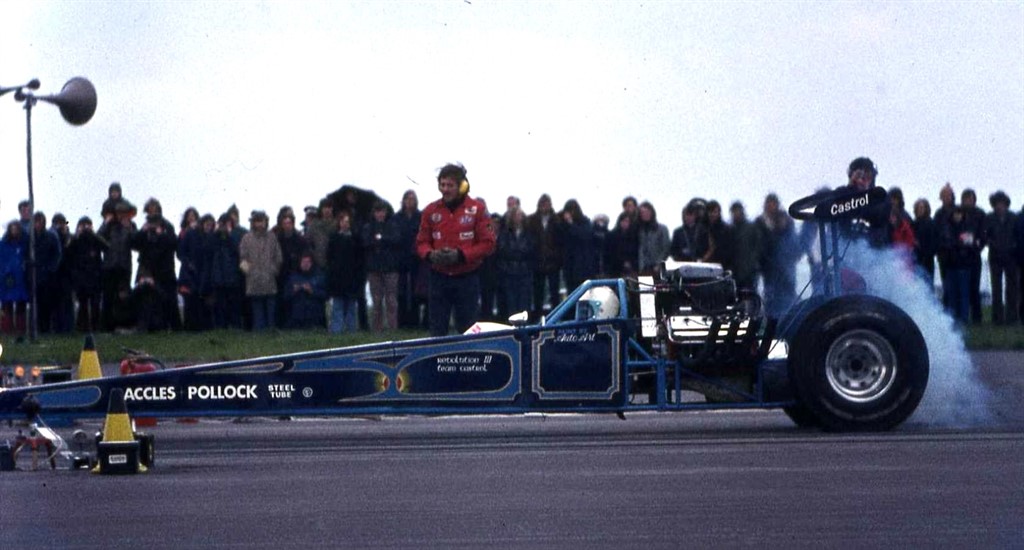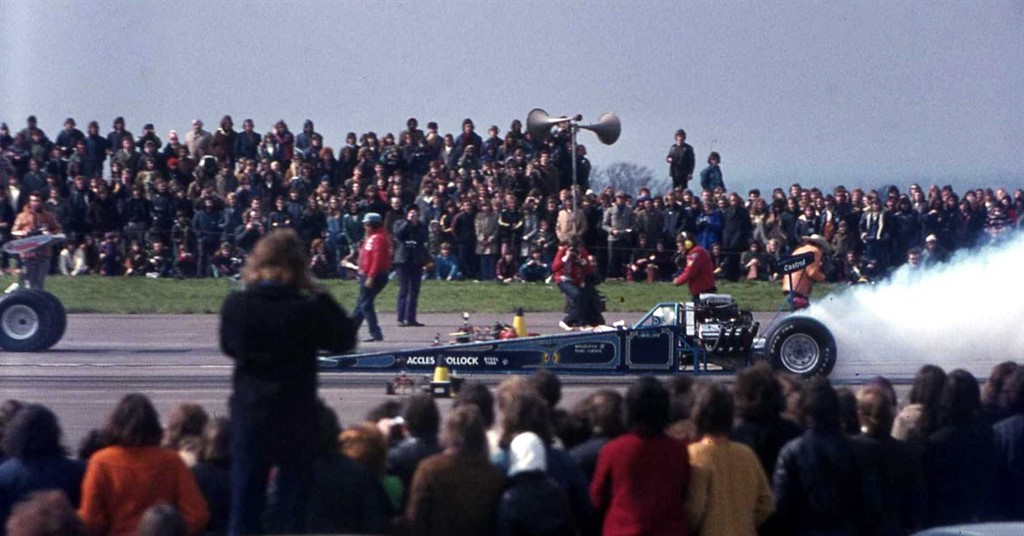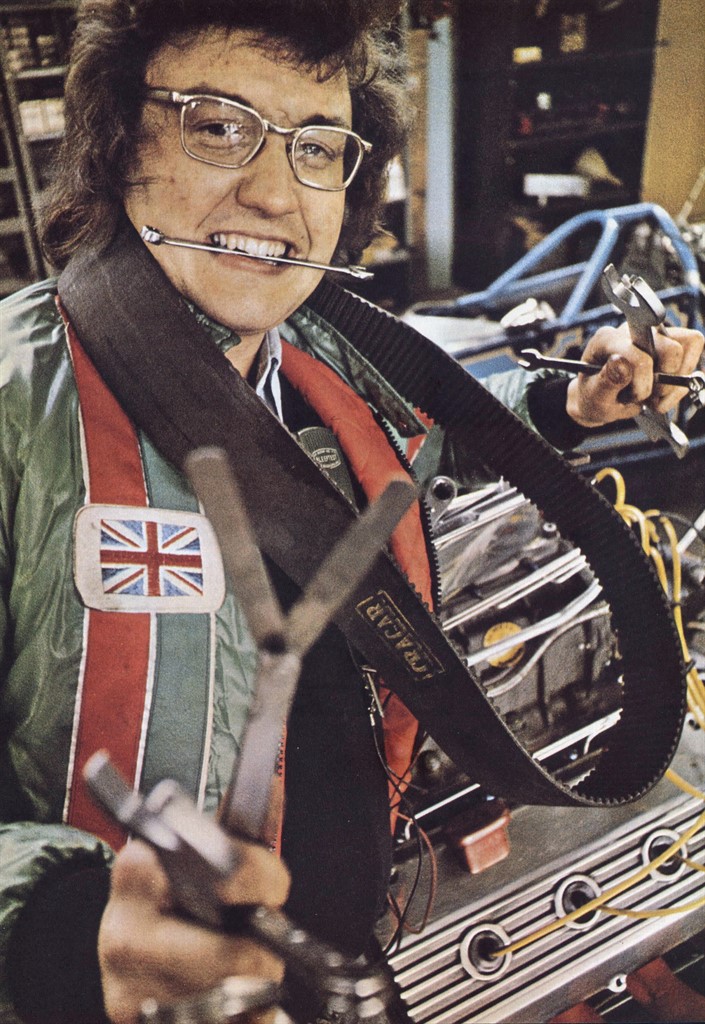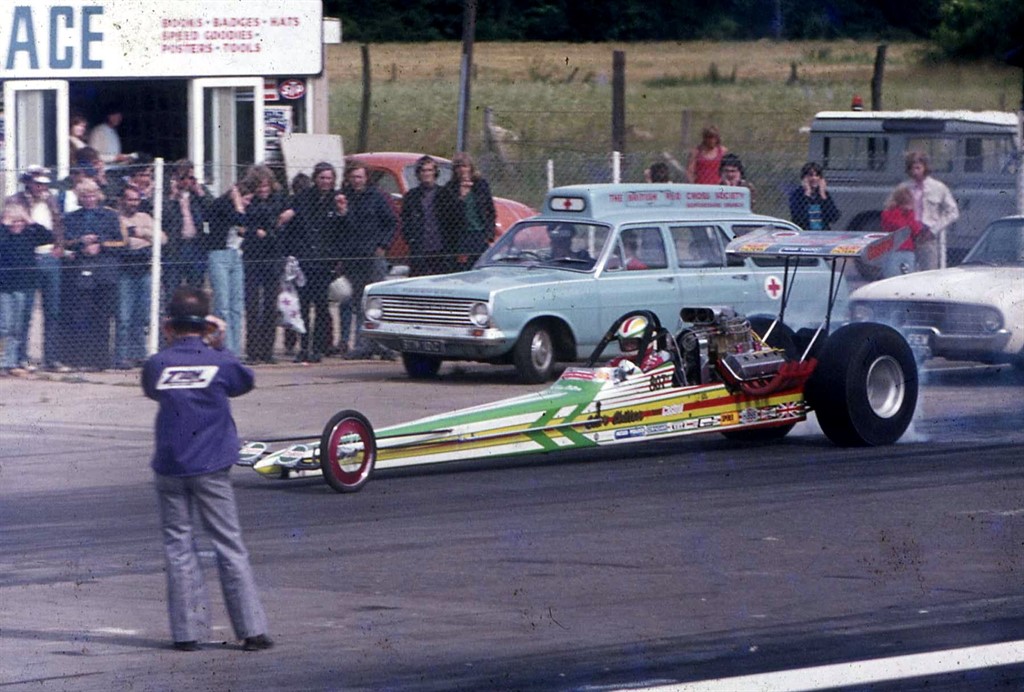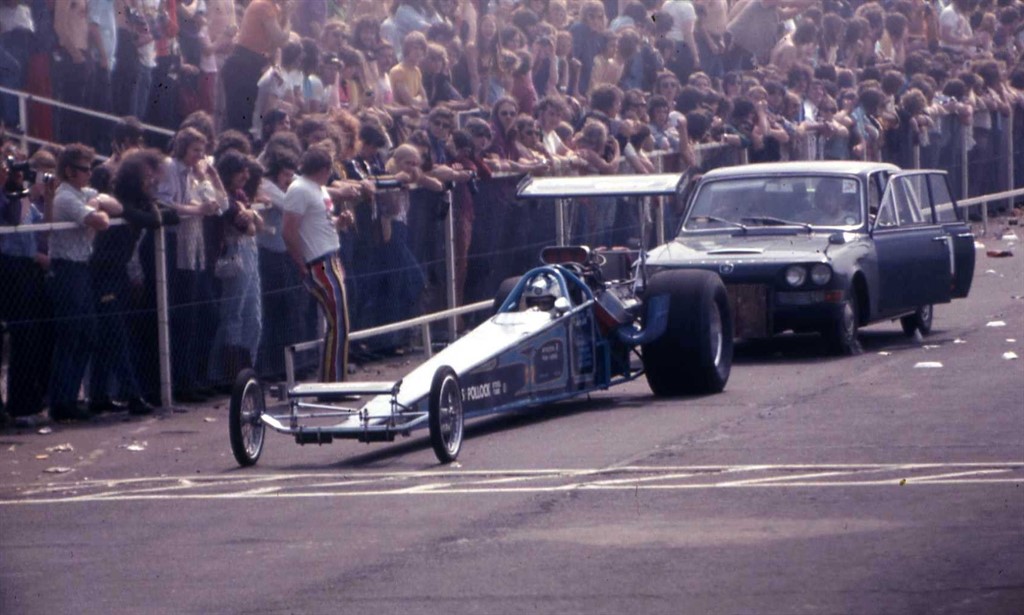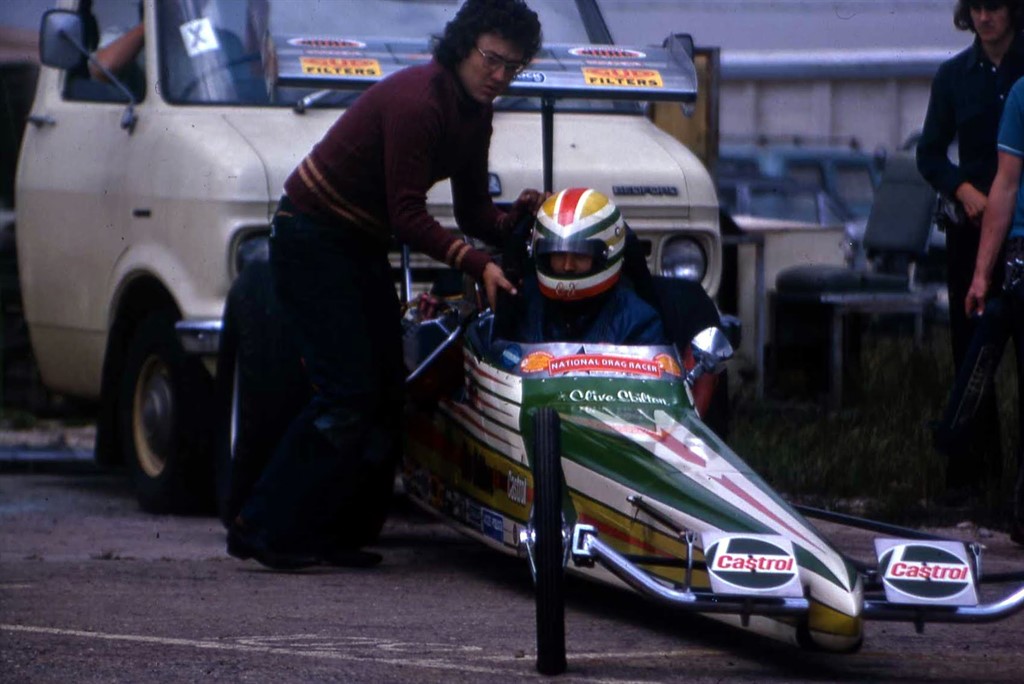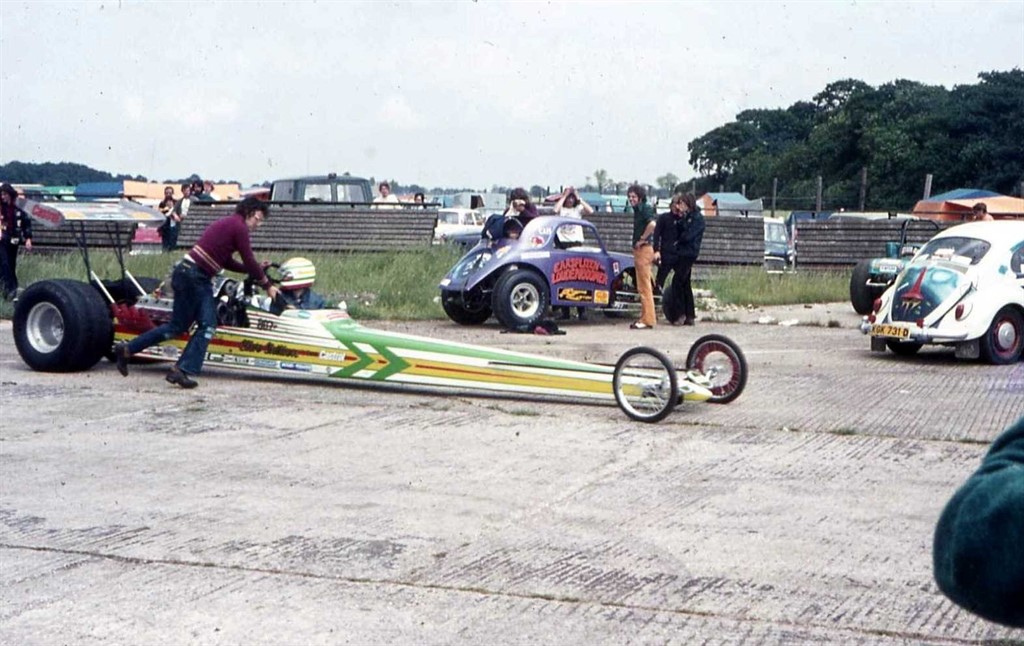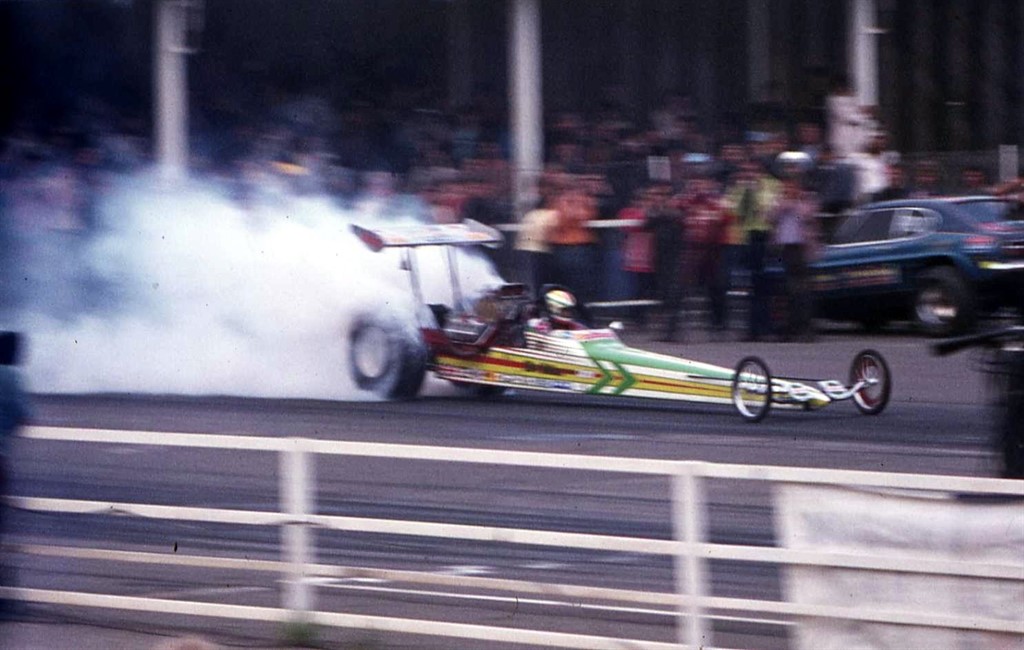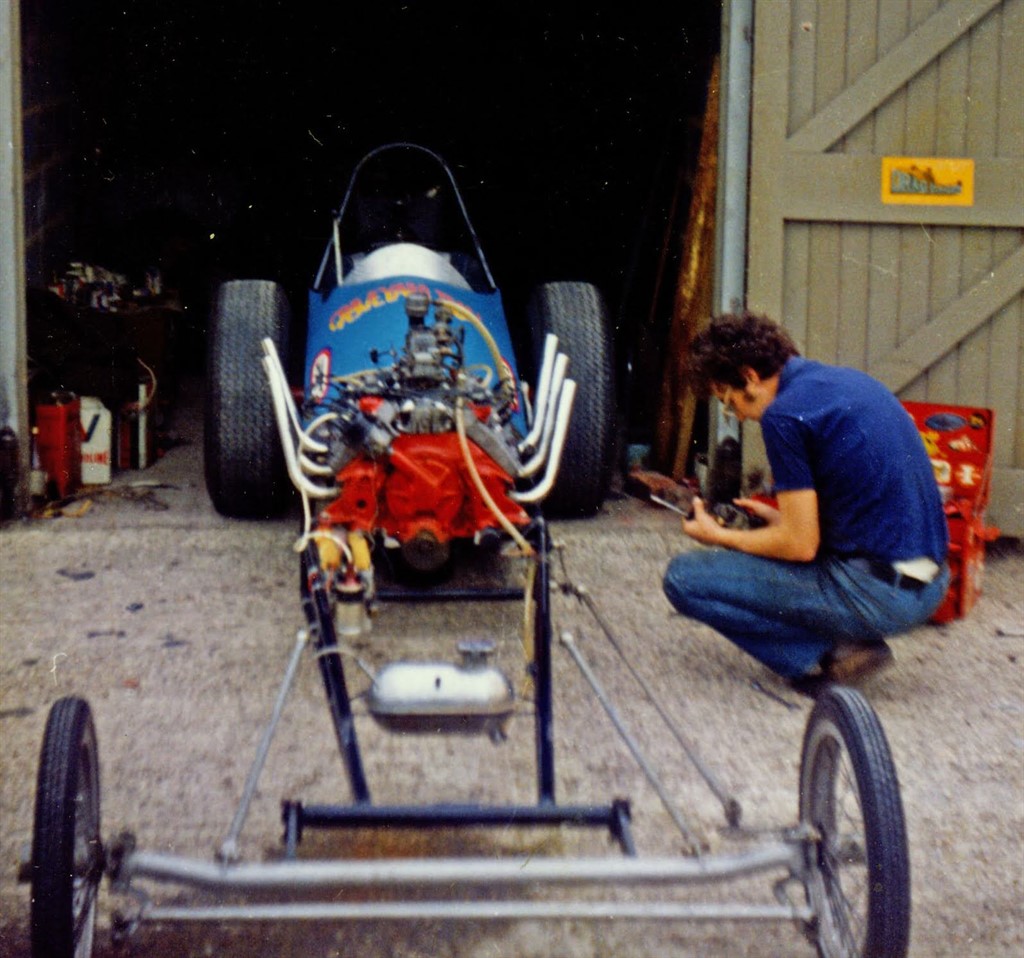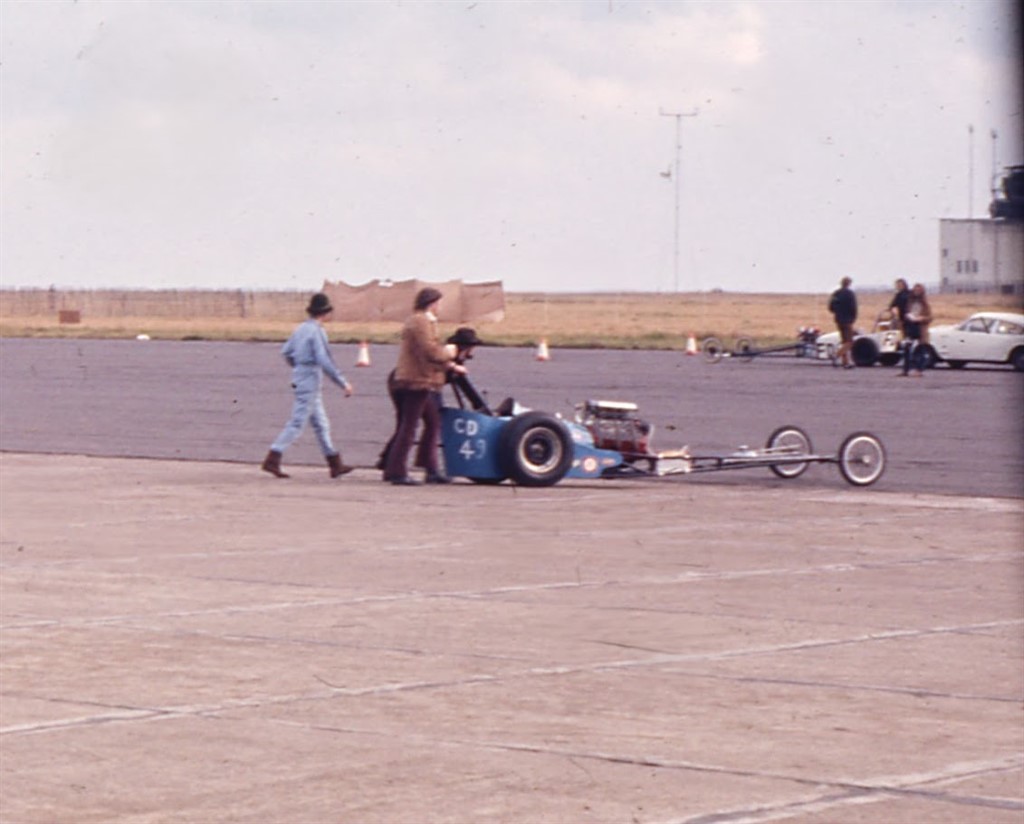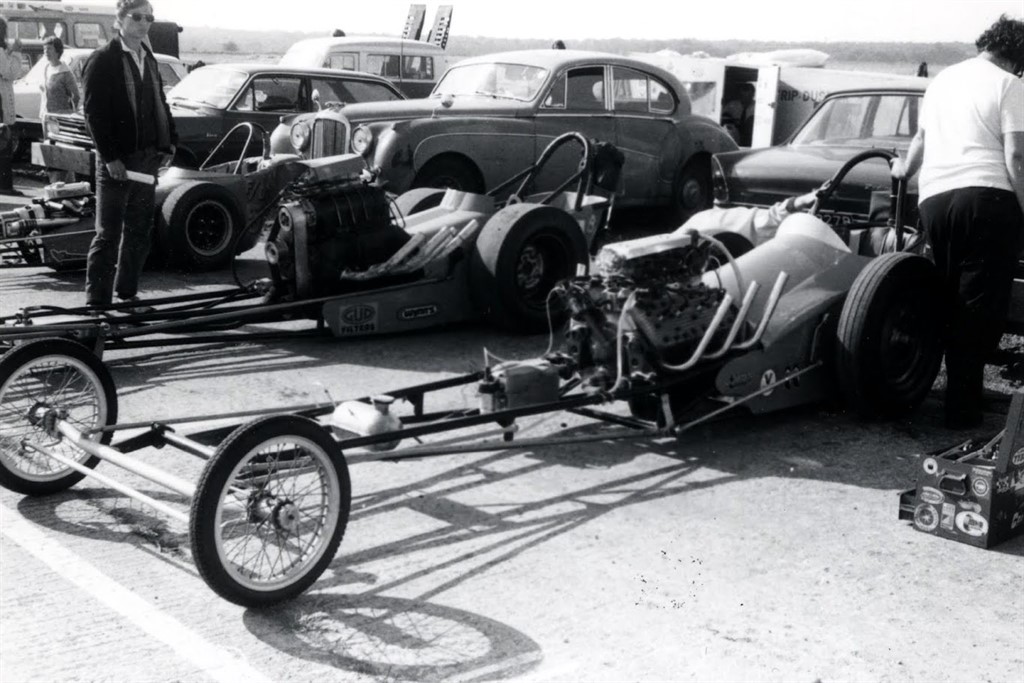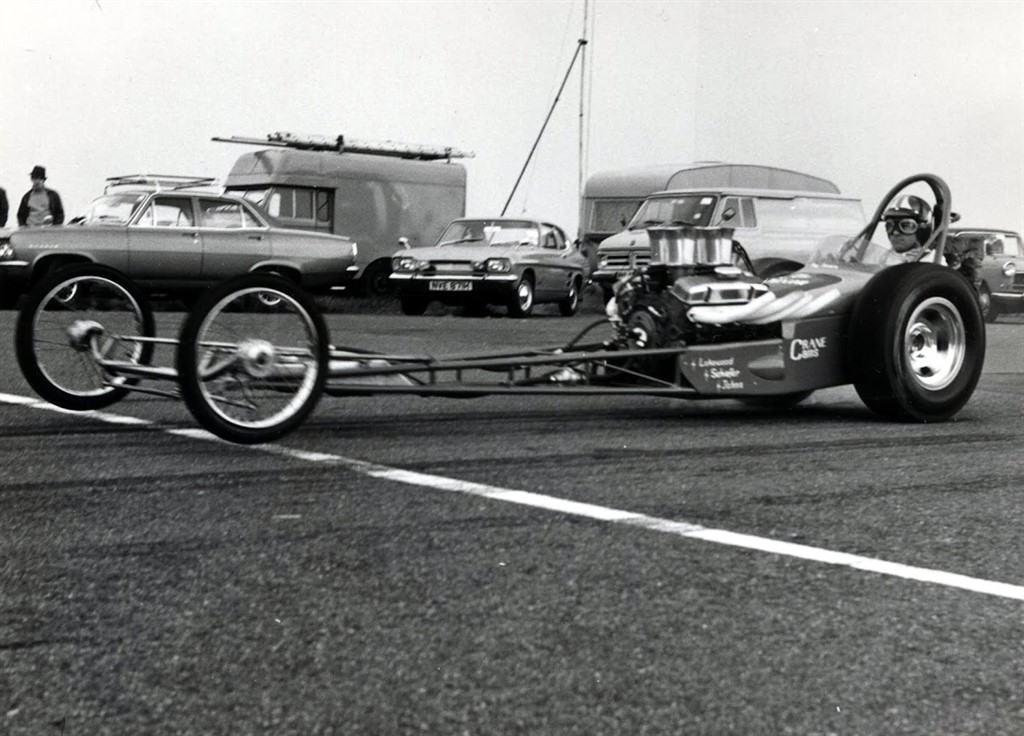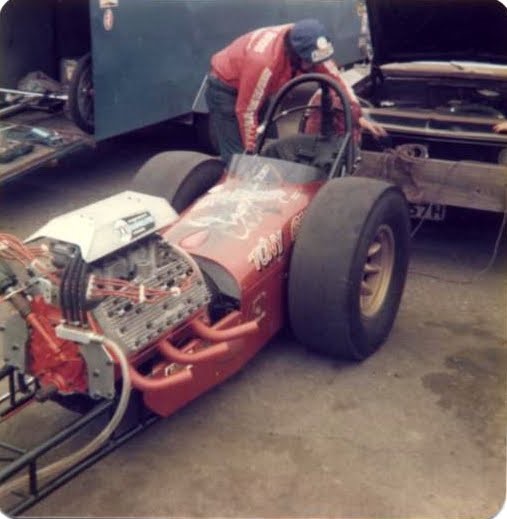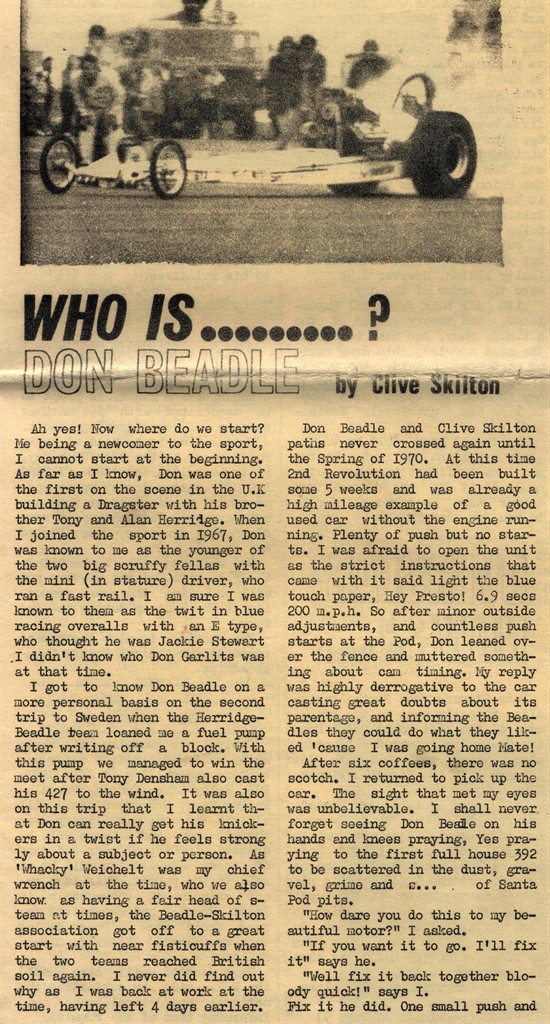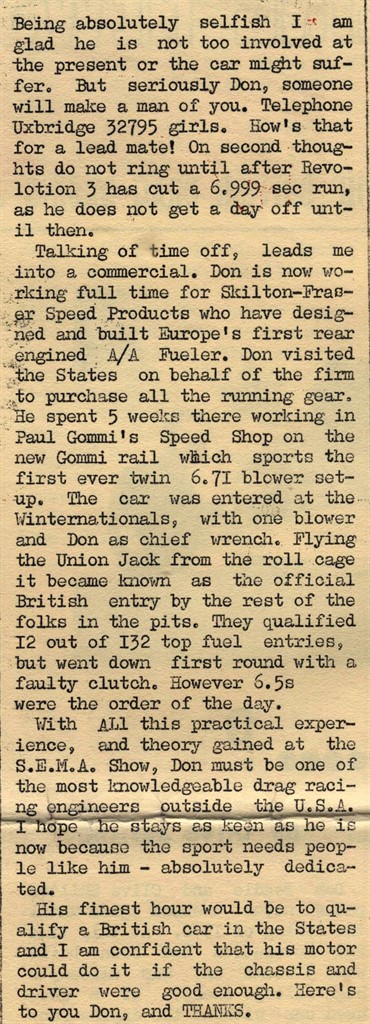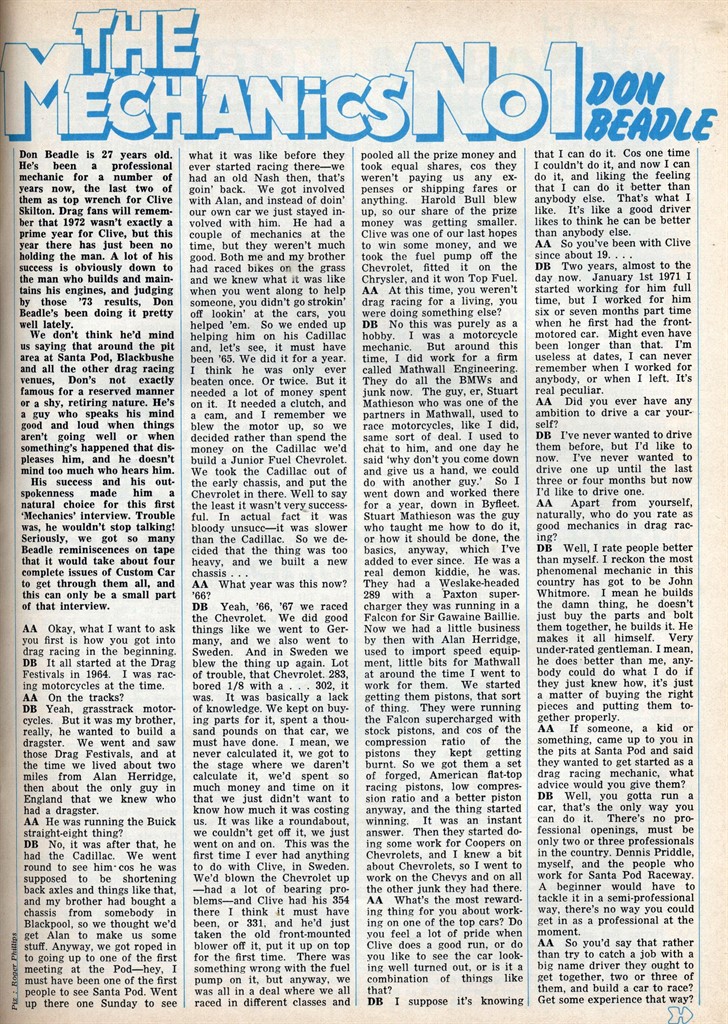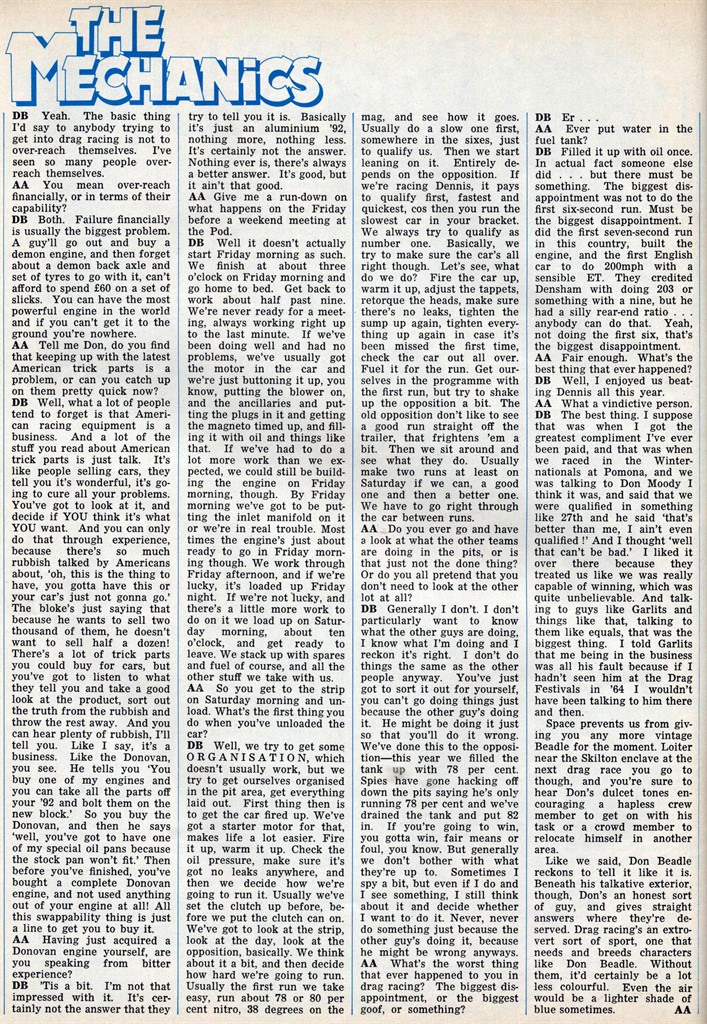The Beadle Brothers - Tony and Don
Part Two – Clive Skilton years 1970 - 1973
Produced by Mick Gleadow with help from Don Beadle and Tony’s widow Jennie. Edited by Nick Pettitt
In 1970 Clive Skilton had brought out a brand-new top fuel dragster, 2nd Revolution. This had a Garlits style, Harold Bull built chassis, with minimal body work painted golden brown and was fitted with a Paul Gommi built 392 hemi, imported from the USA.
|
|
|
|
|
|
Don Beadle was at the meeting when 2nd Revolution first came out and it just wouldn’t start but was firing in the headers. Anyone who was anyone in drag racing in the pits that weekend worked on the car but couldn’t get it to run. Don asked Clive Skilton what was wrong and when he was told the symptoms, Don said “Well the magneto is sparking when the intake valve is open, so the valve timing must be out” Clive was pretty fed up and went for a walk so Don offered to have a look at it, he took off the front cover, blower drive and timing gears and found that the valve timing was 180 degrees out.
Clive came back from his walk to find Don working on it and was shocked to find the engine in bits and exclaimed “what have you done!” Don replied, “If you want it to go, I can fix it” He then re-timed the cam and put the blower drive, front cover and timing gears back correctly and the engine fired up like a streetcar and sounded great. Clive was now worried that there might be other mistakes in how the engine had been put together and even thought about returning it to Paul Gommi. On the Monday after the meeting Don phoned Clive and offered to come to his workshop, take the engine out of the chassis, check it out and put it back together. Clive agreed and so Don took it all apart, which was just as well because he did find other faults, like a con rod being the wrong way round.
Don’s ability to get to the root cause of a problem often paid dividends. As a mechanic he was completely self-taught through experience and reading magazine articles on building racing engines. His first job was working on lawnmower engines for Ealing Borough Council, then he went on to work at Miles Motors, a motorcycle dealership in Uxbridge. That ability and instinct served him well in his whole working career.
|
|
|
|
|
Don then became a member of Clive Skilton’s crew and as the most knowledgeable, he was made crew chief. 2nd Revolution was based at Clive Skilton's Vauxhall dealership in St. Albans and with Don spinning the wrenches it was very successful. At Santa Pod for the July Internationals Clive was in the eights with a best of 8.32/173mph but got shutdown by Dennis Priddle in Quartermaster with an 8.28/183mph. Things got better at Elvington in August as Clive ran a 7.84, the first 7 second run by a UK built car. Then at the August Championships at Santa Pod the team tipped the can a bit more resulting in the fastest time ever outside America with a sizzling 7.56/179mph and Clive took the 1970 Championship title.
Don worked for Clive Skilton full time in 1971 making him the UKs first full-time crew chief. Clive had gained sponsorship from Castrol and now had full bodywork on his car painted in the red, white and green livery of Castrol GTX, Custom Car Magazine called it the flying oil can. Dennis Priddle came out with a new fueler for ‘71 with backing from John Woolfe Racing and Mattel Hot Wheels so there were now two well-funded teams battling for Top Fuel honours. The rivalry was intense and maybe not equalled since, but it wasn’t a bitter rivalry and there was mutual respect. Don’s commitment to racing was total; he used to kneel on the start line and pound the ground with his fist, willing the dragster up the track.
|
|
|
The Easter Meeting saw both Clive Skilton and Dennis Priddle out to take the win. 2nd Revolution was now running 60% nitro and uncorked a sensational 7.37/203mph qualifier straight off the trailer! The first 200mph in Europe. Dennis ran his first seven during Sunday’s Top Dragster eliminations then met Clive in the final who red lit letting Dennis stroke it through for the win. On Monday instead of running in Top Dragster Eliminator the two fuelers ran a best of three. The first race saw Clive solo for the win as Dennis lost fire. In the second race both cars ran identical 7.86 ETs, but Dennis just took it at the top end running 190mph to Clive’s 176mph.
With one win each the final saw both cars loaded for bear. The 8000 jam-packed crowd strained at every vantage point to catch the action. Both cars left the line together with Clive just taking it 7.56/174mph to 7.73/196mph from Dennis.
Both cars were back out for a best of three at HMS Daedalus but a lack of traction and bumpy strip kept them in the eights. Nevertheless, they pleased the fans with three spectacular tyre smoking side-by-side eight second races with Clive taking it two to one.
At the Big Go in May both Clive and Dennis were having handling problems. Clive’s was traced to his right slick being on the wrong way but Dennis’s was more serious getting out of shape at the top end having to back off letting Clive through in their first two machups. It turned out to be a half inch buckle in one of Dennis’s rear wheels putting him out then Clive came out for one more run with a higher load of nitro. The ground was shaking as he came into stage then as he hit the loud pedal the car torqued over sending one wheel up in smoke twisting the innards of the axle to kingdom come and coming to a stop halfway up the strip. Clive received a huge ovation and was pushed back down to the line for a bottle of ‘pop’ from Brian Taylor.
Big Go pics from Antony Billinton’s Collection...
|
|
|
|
|
|
|
The July Internationals saw six entries in Top Fuel including Bjorn Anderson from Sweden and ‘Mad’ Arthur Christie from South Africa. Tony Densham was in Firefly while Allan Herridge took over the driving of Commuter. 2nd Revolution pulled a five-foot wheelstand on Saturday bending the front axle, but they managed to repair it for the big race on Sunday which saw the two rivals Clive and Dennis through to the final. The big fuelers pushed down the fire-up road, burst into life, turned round and edged into stage. On the green Dennis was gone and looked to have it but Clive powered past him just before the eyes with a best yet 7.35/201 to 7.57/199mph.
Internationals pics from Brian Sparrow...
|
|
|
|
The following weekend saw 2nd Revolution heading to Elvington for an Incorporated Sprint Organisation practice day where the team were after the 8.29 standing start quarter mile record achieved by Dennis in Tudor Rose three years earlier. First run was a 7.49 then Clive had to make another run in the opposite direction, the average of the two runs was then calculated.
On the second run the motor began to let loose. Clive knew he had the record in the bag if he could hang on, so he kept his foot in it! With oil flooding out the headers he charged on and when he could see no more, he tore off his goggles which made things worse. Somehow, he kept it straight bringing it to a safe stop totally covered in hot oil. 2nd Revolution had run 7.72 giving an aggregate of 7.605, a new World Record. Incredibly the engine, put together and looked after by Don Beadle, had made 36 runs in competition. The blowup was caused by either a cylinder wall or piston collapse. Large holes were punched in the block and lifter valley.
|
|
This put the team out of action until the last weekend of September at North Luffenham arriving with a newly rebuilt Paul Gommi motor. They were booked for a best of three with Dennis Priddle but intermittent showers allowed for only one race. Both cars had just 4 lbs pressure in the big Goodyears looking for some bite on the slick surface. Dennis was out the hole first but blew a head gasket letting Clive take the win with a 7.82/186mph.
North Luffenham pics from Antony Billinton’s Collection...
|
|
|
|
|
2nd Revolution came out at the season ending Fireworks Meet but rain prevented any full runs. Plans were already being made for Revolution 3, a new dragster for 1972. Not wanting another hot oil bath Clive decided this dragster would be rear engined!
|
|
|
Revolution 3 had a 240-inch chassis, designed by Ian Fraser who lived in nearby Whitwell, Herts, where Clive had now moved to. It was a scaled-up version of Ian’s rear engined transverse Ford V6 rail called Econorail and welded up in chrome moly by Weld Equipe who also built the body. The very first rear engine Top Fuelers looked more like front engine cars in body style but with the engine at the back, whereas Revolution 3 was very angular with a deep chassis, similar to how Top Fuel cars look today. The chassis behind the driver was later redesigned and the top rails removed as they got in the way during engine teardowns.
The car was finished at Ickleford Engineering near Hitchin, Herts and was ready for the annual Custom Car Show at Crystal Palace in February 1972 where it was displayed with aerodynamic side panniers fitted, similar to Don Prudhomme’s Mattel Coca Cola Wedge fueler but these were removed and a traditional rear wing added before it came out to race.
|
|
|
|
After the car was built, the racing operation was moved to a workshop on an industrial estate off Walsworth Road in Hitchin. Don was still living in Uxbridge and drove to the workshop every day. Don and a local guy Graeme “The Weld” Stuart worked around the clock on the car, and they made themselves ill through exhaustion. After working on the car Don would drive home, a distance of about 55/60 miles and then drive back to Hitchin around midday. I sometimes went round to the workshop in the evening to see Don and the lads working on the car. It certainly brought it home just how much work is involved in running a Top Fuel car, even in the 1970s. Working on your own can be hard and so Don would work until late at night with some local lads who came after work. There was one lad called Tom, who was an Axel Rose look alike and into heavy rock; he was very entertaining. Mike Burt and Clive Morley also worked on the car.
Revolution 3 debuted at Santa Pod’s Easter Meet. Dennis Priddle also debuted a new fueler soon to become known as Mister Six and was a traditional slingshot design. Clive’s first full pass produced an arrow straight 7.75/179mph saying much for the chassis design and for the capabilities of NDRC Mechanic of the Year Don Beadle, who put the 392 hemi together.
|
|
|
|
The months between Easter and August saw Clive turning times of 7.2 and 200mph but just not managing to go any quicker while Dennis was turning times in the sixes. Then at the August Championships the final race saw Clive loaded with 85% against Dennis. On the green Clive got the hole shot but Dennis caught him at the finish line with a 6.67 (no speed given) to Clive’s 6.89/211mph, the first side by side six second race in the UK. Earlier Clive also recorded the first side by side 200mph race alongside Allan Herridge in Firefly.
|
|
|
|
|
|
|
|
|
|
In September Revolution 3 was at Brighton for the annual Speed Trials along Madeira Drive. There was little traction and Clive made two wild smokey runs at 8.7 and 8.1 to please the fans who lined the terraces. The team were back at Elvington at the end of September for the ISO Records Weekend. This time they were out to break the standing start 500 metre record which they did with an 8.4 elapsed time at an estimated 240mph!
|
|
|
|
February 1973 saw Clive Skilton and Dennis Priddle in Pomona California for the NHRA Winternationals. They had bought American built cars and were planning on racing them at Pomona before bringing them back to the UK. They both qualified for eliminations but then it rained. The meet was rescheduled for the following weekend which also saw rain. It was rescheduled again for a third weekend but they couldn’t stay any longer and returned to the UK with their cars.
Clive had bought the ex-Kuhl and Olson car which was one of the most beautiful rear engined Top Fuel car ever built. It was actually Dennis Priddle who put Clive in touch with Kuhl and Olson during an NDRC trip to the NHRA Supernationals in November. The car had won the 1972 NHRA Winternationals with Carl Olson driving but then crashed at Amarillo, Texas. It had already been sold to a racer who was retiring his front engine Top Fuel car and had put a deposit on it but because of the crash his deposit was returned. Mike agreed to rebuild the car for Clive to race at the Winternationals. It was renamed Revolution 4 and was rebuilt at Woody Gilmores where it was re-jigged, straightened and brought up to the latest ‘73 specs. A beautiful all new body was made by Tom Hanna and finished off with a new Castrol paint job. Apparently, Castrol were not keen on the green paintwork because it didn’t quite match the Castrol shade of green used on Castrol Oils and marketing materials. When the car was being painted, Don was asked about Burma Oils, which was Castrol’s parent company; in the States people had only vaguely heard of Burma.
|
|
|
|
Don Beadle made quite an impression on Carl Olson, as this passage from an article on Eurodragster shows...
Carl Olson... ‘The first time I met Clive, he brought Don Beadle with him to pick Mike Kuhl’s brain, and at that time Don hadn’t been anywhere but was as smart as a whip and a really good mechanic, then afterwards Mike did some engine work and we sold Clive some parts. We had the car (that Clive bought) built in 1971 and it was one of the first in the rear engine revolution. We saw immediately what was happening and said ‘We’ve got to have one of those’. In 1972 we crashed the car and rebuilt it then sold it to Clive in 1973. So Clive’s was our original rear engine car. The car won the NHRA Winternationals, the Orange County International Raceway All-Pro Series and a bunch of other big races.
During those three weeks that they were here, Kuhl was putting Don Beadle through school, building engines and machining parts, and he was a smart guy and a sponge for knowledge about these engines. He wanted to go back and kick everyone’s ass in England and he did. While he was here, we discovered that he was only twenty-one years old. Don was also an IndyCar mechanic for many years after drag racing and he currently lives in Indianapolis with his family. What a great guy, I used to run into him at Indianapolis when I went to the Indy 500’.
Don Beadle had built a 446 cu in Dodge hemi for Revolution 4 which debuted on April 8th 1973 at the NDRC’s first meet of the season at the Royal Navy's Wroughton facility. On its maiden pass on British soil with just 60% in the tank Clive ran a superb 7.18; the speed clocks were not working at this meeting. Revolution 3 was also there now in the hands of ‘Hillbilly’ Roland Pratt and repainted in its sponsor's Accles & Pollock colours.
In the afternoon the two Revolution fuelers ran a best of three. Clive took the first matchup with a 7.10 to Roland's 8.44. Next race saw Roland drop into the sevens with a 7.83 but Clive still took it with a 7.11. The tables were turned in the final when Clive bogged off the line and Roland blasted to the win with a fine 7.71.
Wroughton pics from Pete Blake...
|
|
|
|
|
|
|
|
|
|
Revolution 3 became the sister car to Revolution 4 and both cars were based in Hitchin, Roland Pratt was sometimes at the workshop in Hitchin as well. The logistics of getting to the track were quite a challenge, particularly running two Top Fuel dragsters. I remember the team running both cars at a NDRC meeting at Fulbeck, near Newark, there was a thrash all day on the Saturday and we finished both cars at about 9pm, and then they had to be loaded up and towed up to Fulbeck.
Being one of the few in the workshop that wasn’t falling asleep, I was volunteered to tow the box trailer with one of Clive’s Bedford CF vans. I had never towed a 30-foot box trailer before, but we got up to the hotel at about midnight, managed a few hours sleep then got up at 06.30 to get the cars to the track. I can’t remember how the meeting went but I remember Clive offering me a lift back in his Mercedes instead of going in one of the vans. We all stopped at Newark services for a meal, paid for by Clive, which was greatly appreciated.
Running in Top Fuel always attracted attention in the pits and Don would get chatting to spectators. I remember there was a girl named Sarrat, who I believe was a friend of the late Phil Cornish, who Don had recruited by now being an engine rebuilder in Harrow. Sarrat had a flat in Gloucester Place, Earls Court and often held parties and Don, Tony and I would get invited. Those parties were something else; in the 1970s you could drive up and park on the street outside the flat without any problem, then find your way home in the early hours. Entry was often with a Party Seven or a cheap bottle of wine. Don was usually in the kitchen at parties – he must have inspired that song!
One of Sarrat’s friends lived in a flat above a wool shop on Putney High Road, so we got invited to parties there as well. The floor was very springy and I remember everyone being told to stop dancing otherwise we would all end up in the wool shop! It was at one of these parties that Tony met the landlady’s daughter Jennie, they started going out - and then got married in 1976.
Tony and Don’s own parties at their parents' house were not to be missed either. Usually they were held while their parents were on holiday (I’m sure they must have known!) The parties were usually in July, around St. Swithins Day. So if you got drunk, it would last for 40 days and 40 nights, I think a lot of people tried!
One year I was so bad after the party I lost my shoes and they were found a few days afterwards behind the coal bunker! Don lent me some shoes, 2 sizes too big though! I wore them at a car show in Watford the following day where we had Motor Psycho on display. The parties were actually pretty chilled and there was no aggravation, it was mainly drag racers chatting about racing - and rock music, like Mountain, Credence Clearwater Revival, Doobie Brothers, JoJo Gunn. Tony had very good taste in music and I got to know some great bands.
You could bump into anyone from drag racing at the St. Swithins Day parties I think Tony and Don went around the pits with invitations. At one party they put on the 1964 Drag Festival LP and Capitol Records Big Sounds of the Drags, the volume was turned right up, which all the drag racers appreciated, not sure what the neighbours thought!
Don was fully involved in running Clive Skiltons top fuel team during 1973. The factory block iron Chrysler 392 was still being used in Top Fuel but was prone to cracking around the crankcase webs and could not be repaired. Because of this, Clive bought a 417 Donovan for Revolution 4 and ran a new speed record of 224mph at Santa Pod in October.
|
|
|
|
|
|
|
|
|
In the early to mid 1970s there was a bit of a power struggle in UK drag racing. Santa Pod and the BDRHRA were running successful race meetings with big crowds and so could pay top teams to run there. In the rival camp there was the National Drag Racing Club (NDRC) and Clive Skilton's European Dragways as a co-promoter. These race meetings were held at non-permanent venues up and down the country. As promoter, Clive had to draw in big crowds, which meant having Top Fuel and Funny Cars. Quite often Dennis Priddle would run at NDRC meetings as competition for Clive and Scandinavian racers would come over as well with big international meetings held at Silverstone, Wroughton and Blackbushe.
Don’s motivation was to race, pure and simple, without the backdrop of politics or ‘promoter wars’ and so at the end of 1973 he finished working for Clive Skilton and went to work for Nicholson McLaren to build DFV Formula 1 engines. Don was told about the job by Steve Clarke, owner of Nimbus Motorsport. While he was at McLarens, Don also helped Dave and Roz Prior who were running the ex-Mister Six dragster.
Nicholson McLaren was owned by a Kiwi, John Nicholson, who built and raced Formula Atlantic cars. He also built an F1 car, called the Lyncar, which he raced at the British Grand Prix in 1974. Don quickly learnt about DFV engines and built the engine in Emerson Fittipaldis McLaren M23, in which he won the Formula One World Championship that year.
Later Nicholson McLaren was bought by Ron Dennis and went on to be a highly successful Formula 1 team.
Don then went to work for McLaren Engines which was based in Livonia, Michigan close to Detroit, because General Motors was putting money into the company. McLaren Engines was created in 1969 when the New Zealand-born company founder and racing legend Bruce McLaren established a North American base to support his initiatives in the Can-Am and Indy racing series. McLaren won the Indy 500 in both 1974 and 1976 with Johnny Rutherford behind the wheel.
Don’s experience with the F1 DFV engine was invaluable because McLarens were developing a de-stroked DFV with a turbo, which became the DFX and was run on methanol. This became the dominant engine in United States Auto Club (IndyCar) and replaced the Offenhauser 4-cylinder turbo which had been the mainstay for oval track racing from 1934 through into the 1970s.
After working near Detroit, Don moved to California when the engine programme was moved there. In 1978 Don came back to the UK for Indycar races, the first one at Silverstone and the following weekend at Brands Hatch. AJ Foyt, Gilmore Racing Team won the first race at Silverstone with Team McLarens Johnny Rutherford coming 5th. Ex-drag racer Danny Ongais (who came to England for the 1965 Dragfest running the first seven and first 200mph in this country), set fastest lap and was in Pole Position. At Brands Hatch the following weekend, the race was won by Rick Mears in a Penske and Johnny Rutherford came 3rd in the McLaren.
Don then went to work for National Engineering who was developing a stock block American Motors Company IndyCar engine. This was all aluminium, apparently produced good horsepower and was a nice engine. It ran a few times in an IndyCar but GM wanted the stock block type engine to be a Chevy so it didn’t progress.
Don went on to work for IndyCar teams such as Patrick Racing, with Mario Andretti and Gordon Johncock; Dan Gurneys All American Racers; Doug Shierson Racing, with Al Unser Junior; Mayer Motor Racing; Sal Incandella Racing, with Arie Lyundyke. All of these drivers were Indy 500 winners. He then worked for Tom Walkinshaw Racing with the Jaguar V12 in the World Sports Car Championship and then worked for Players Forsyth until 2011 when he retired. After retiring Don worked on a Shadow DN8 Formula 1 car owned by Phil Gumpert, a wealthy food company owner with a collection of cars including a Porsche Spyder, Ferrari Dino and a Formula Vee. The Shadow F1 car raced in the Historic Grand Prix Association.
Don has fond memories of his time in drag racing, and the friends he made, the knowledge he gained and the opportunities he was able to take enabled him to have a successful career in motorsport, for which he is grateful. He would like to have been involved in drag racing in the USA, which he still takes an interest in, but the opportunities just didn’t come along.
Meanwhile Tony was involved with the National Drag Racing Club (NDRC) and was on the Committee, which would have taken up a lot of time. By then he was starting to make plans to build a flathead dragster. He also helped Bob Bailey put together a low budget flathead dragster which was named Graveyard Train, after a Creedence Clearwater Revival track (on the Green River album), one of the brother’s favourite bands. This chassis was borrowed from Midland racer Brian Lockley. The motor was a 239 Ford it had aluminium heads, 3 carb manifold, with a manual box. Bob Bailey drove it for the first time at North Luffenham on 25/26th September 1971, where it ran 12s; Bob came back from the first run with the biggest grin! “That was great” he said. Bob also ran the car again at Santa Pod on 10th October.
|
|
|
|
In 1972 Tony continued being involved with the NDRC and at the May 20/21st North Luffenham meeting he was joint NDRC Steward of the Meeting, with Alan Wigmore. He also raced at this meeting in Production, which I think was in his Ford Falcon.
Tony was now starting to build up his own flathead dragster and had bought Ray Hoare’s front engine Saxon dragster less engine and was building up a full race flathead for it. He called it Gravedigger and it was finished towards the end of the 1973 season, Tony raced at Santa Pod on 15/16 September, 6/7 October and 21 October. Gravedigger was a well turned-out car, with a Candy Red paint job and Tony’s attention to detail was evident. I used to help out on the car and in fact I once towed the trailer to Silverstone with my Ford Corsair. I had to get the AA out though the night before to cure a misfire and got told off by the (angry) AA Patrolman “This is pure lack of maintenance!” I couldn’t argue with that.
|
|
|
During 1973 I decided to sell Motor Psycho and started looking for more affordable and fun racing and got interested in running a Flathead engined dragster inspired by Tony and Dons Gravedigger. Also, the use of the Flathead engine was becoming popular again. With the proceeds from the sale of the Ford Pop Altered Motor Psycho I paid up for the NDRC trip to California and went to America with Tony and Don, we stayed in an apartment in Long Beach which Dale Vaznaian had got for us. On the first night Dale took us to the Hyatt House Hotel in Long Beach, Dale had a patty melt – I had no idea what that was! Dale’s brother Dennis came too, and the English girls were impressed by his huge moustache!
Among the meetings we went to was the Manufacturers Funny Car meeting at Orange County – 64 funny cars! Dale knew Jim Terry, an independent racer with a Mustang funny car which was driven by Gordy Swearingen, a capable funny car driver. During the week we went to Donovan, Iskendarian and Sid Waterman Racing Engines, where Rex Sluggett worked for a while. We also went to Friday evening bracket races at Irwindale, funny cars and top fuelers often tested there. The NHRA Supernationals at Ontario Motor Speedway was the highlight of the trip, among many fantastic memories was a car that really got my attention, the Jade Grenade top fueler.
Tony had made prior contact with the United Flathead Racers Association (UFRA) and so we took a trip out to meet McCloskey and Jordan at Valencia Autoparts up at Newhall, California. We went on a Monday, which of course is the night everyone watches NFL. McCloskey and Jordan looked after us superbly. We had a nice meal, a few beers and stayed the night.
The McCloskey and Jordan car was immaculate and had run low 10s on pump gas. It later ran 9.85. UFRA raced at Inyokern Airport, Antelope Valley, Irwindale, Bakersfield and Las Vegas. We also met Joe Monaghan and Tony Miglizzi. I remember that both Tony and I bought lots of parts including, intake manifolds and cylinder heads and we brought them back as hand luggage, which you could do in those days! The success of the UFRA led Tony to set up the British Flathead Racers Association (BFRA). The flathead movement had kept going in the UK through Ken Cooper being a regular competitor at NDRC and British Drag Racing and Hot Rod Association (BDRHRA) meetings.
More on Tony and the BFRA coming in part 3, The Flathead Years...
Who is Don Beadle by Clive Skilton...
|
|
|
|
The Mechanic Don Beadle...
|
|
|
